Agia Napa Monastery
The charming Medieval Monastery of Agia Napa stands in the middle of the village and was built in the form of a Medieval Castle around 1500 AD.
The monastery is partially built underground and cut into the rock, surrounded by a high wall. It is dedicated to ‘Our Lady of the Forests’, with the name coming from the Ancient Greek word for wooded valley (‘Napa’) as a result of the area’s past topography. The monastery was restored in 1950 and in 1978 became an Ecumenical Conference Centre, serving churches in Cyprus and the Middle East. After the re-establishment of the Holy Metropolis Constantia Ammochostos (Famagusta) in 2007, the monastery came under the administration of the Metropolis.
A new church – also dedicated to the Virgin Mary – was built in 1994, south west of the monastery.
The ancient sycamore tree in front of the south gate is believed to be over 600 years old.
Makronissos Tombs
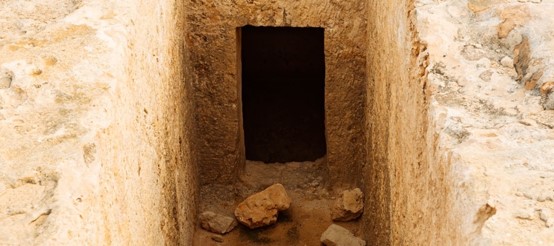
The Tombs of Makronissos are situated west of Agia Napa and consist of 19 rock-cut tombs, a small sanctuary and an ancient quarry. The sanctuary is a simple rectangular enclosure, made of large irregular blocks. The tombs were used during the Hellenistic and Roman periods, and although they were subject to severe looting over the years (from 1872), archaeologists believe that the deceased were placed in clay sarcophagus that were originally covered with three flat tiles. The tomb’s rectangular entrance originally closed with one or two slabs, and Pyres were found on the surface, characteristic of Greek burial customs. Most of the chambers are almost identical with a rectangular trench in the middle and three benches at the side.
The Agia Napa Aqueduct
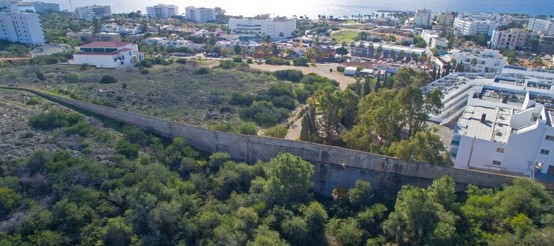
Located within the boundaries of Cape Gkreko and Protaras, the Agia Napa Aqueduct was originally a Roman structure, with Frankish alterations. Its main purpose was to deliver water to the local monastery and the surrounding region, and it is one of the few preserved aqueducts on the island. Its construction is complicated and required much expertise, along with a comprehensive system of regular maintenance to repair accidental breaches, clear the lines of debris, and to remove the build-up of naturally occurring chemicals. In years past, the aqueduct carried water from a source of the water to be found somewhere on the hills between Agia Napa and Protaras. Up to the year 1974 the original visible route of the channel was marked by a barrel_shaped structure at the locality of Mana tou Nerou, Known traditionally as the House of the Greeks.to the large stone reservoirs of the village. Substantial conservation work was carried out on the structure from 2006 – 2008. In September 2006 the project was incorporated in the European initiative INTERREG IIIA Greece Cyprus. The project is co-financed with 50% by the European Union Fund for Regional Development and 50% by national sources.
Agios Antonios Church – Kelia village
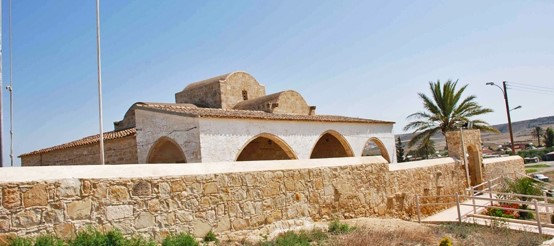
Agios Antonios Church is located 9km west of Larnaka (Larnaca) in the village of Kelia, and is one of the most important Byzantine churches of Cyprus, possibly dating back to the 9th century.
The building is a three-aisled vaulted basilica which once had a dome, and the church contains significant wall paintings from the 9th, 11th and 13th centuries.
Agios Georgios Arperas Chapel

The chapel of Agios Georgios Arperas is situated about 2km from Larnaka (Larnaca) in the village of Tersefanou, where the Medieval village of Arpera once stood.
The chapel was built by the Dragoman Christofakis Konstantinou in 1745 and has a fresco depicting himself and his family as founders, as well as many icons signed by the painter Ioannikios. The family painting is believed to show the Dragoman offering the church to Saint George as thanks for the successful completion of the difficult project of Larnaka’s aqueduct ‘Kamares’, of which he was in charge of. The office of Dragoman was introduced in Cyprus at the start of the Ottoman Rule and was abolishedduring the Greek Revolution against the Ottoman Empire in 1821. Dragomans acted as liaisons between the Pasha (high ranking military official) and the local people. They were the most important political figures after the Pasha.
Agios Lazaros Church

Located in its own square in the centre of town, the magnificent stone church of Agios Lazaros is one of the most remarkable examples of Byzantine architecture in Cyprus and lies over the tomb of the saint. Built by Byzantine Emperor Leo VI in the 9th century, the church was restored in the 17th century. Although the three domes and original bell tower of the church were destroyed in the first years during Ottoman rule, the gold-covered iconostasis has survived to today and is a superb example of baroque woodcarving.
Saint Lazarus came to Cyprus after being resurrected by Jesus. He was ordained as Bishop of Kition by the Apostles Barnabas and Paul and lived in the town for 30 years. His tomb can be seen under the sanctuary. The saint is so revered that a procession is held in his honour eight days before Easter. During the procession, the icon of Saint Lazarus is carried through the streets of Larnaka (Larnaca). Next to the church is the Byzantine Museum, which exhibits important religious icons, artefacts and relics.
Agios Minas Convent
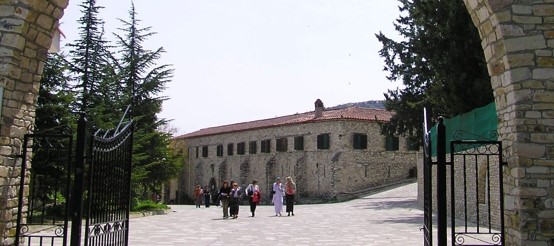
The convent of Agios Minas is located in the village of Vavla and dates back to the 15th century.
The building is a mixture of Byzantine and Gothic styles with the pointed vault of traverse ribs and side porticos, and consists of a church, cloisters and other monastic buildings. On the north and south walls there are two large paintings of Agios Georgios and Agios Minas dated 1757. In addition to their religious duties, the nuns at the convent practise icon painting, along with selling fruit and homemade preserves. Please note that modest attire is required to enter the church.
Angeloktisti Church

This 11th century Byzantine church of Angeloktisti (which means ‘built by angels’ in Greek) was erected over the ruins of an Early Christian basilica of the 5th century.
The original apse of the basilica has survived along with one of the finest pieces of Byzantine art on the island – a rare 6th century mosaic of the Virgin Mary and Child between the two archangels Michael and Gabriel, which rivals the mosaics of Ravenna-Italy. Such mosaics from this period have only been discovered in Cyprus and Mount Sinai. After the 11th century, additions were made. The Franks added a new facade and bell tower. The sanctuary houses a very old and unique icon of the 10th century, that depicts the Virgin Mary, Saint Lazarus and the Evangelist Loukas. According to legend, the three were family friends and all met in Kition during the island’s first difficult Christian years.
Kebir-Buyuk (Great) Mosque – Larnaka (Larnaca)
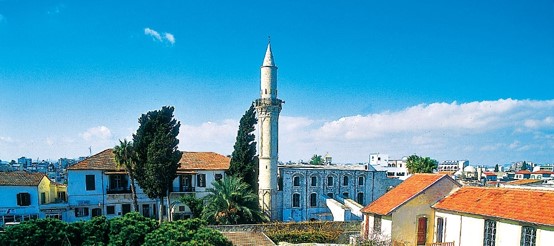
The Kebir (Buyuk) mosque is possibly the first Ottoman mosque in Cyprus, and was originally a Catholic church dedicated to St. Catherine in the 13th – 14th century, before its conversion.
The oldest reference of its existence is found in a 1747 document of Bekir Pasha, creator of the Larnaka (Larnaca) aqueduct. The document specifies that a public fountain at the mosque should receive water from his aqueduct, and this public fountain still exists outside the mosque today.
Choirokoitia Archaeological Site (Neolithic Settlement)

The archaeological site of Choirokoitia is a remarkably well-preserved settlement from the Neolithic Age that has been listed as a UNESCO World Heritage Site since 1998.
Remains from all phases of the Neolithic Age are evident in the settlement, and provide an insight of living conditions in the region during prehistoric times, as well as how the Neolithic culture was spread throughout the region. Five characteristic cylindrical shaped dwellings have been reconstructed near the settlement, using the same construction methods and materials used in Neolithic times. The dwellings are fitted with replicas of household objects found inside the original dwellings, thus providing a vivid representation of how they actually were in the past. The vegetation around the dwellings consists of native plants and trees that have grown in Cyprus since Neolithic times.
Hala Sultan Tekke
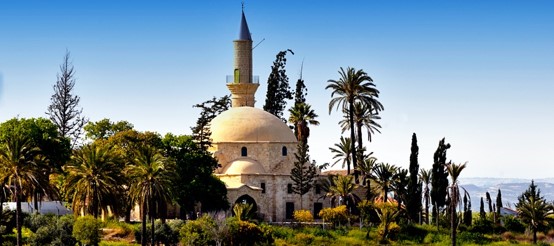
Located on Larnaka’s (Larnaca’s) Salt Lake, the mosque was built in 648 AD, on the spot where Umm Haram died when she fell off her mule, during one of the first Arab raids on the island. According to tradition, Umm Haram was related to the Prophet Mohammed. Grand Chalif Moavia, who was taking part in the expedition, immediately ordered the construction of a mosque at the spot where she had fallen and died. The mosque was first renovated in 1816 and more recently in 2002 by UNOPS, when archaeological excavations also revealed that the place had been inhabited since Neolithic times. Today, the mosque stands as one of the most important holy places of worship for Muslims, ranked immediately after Mecca, Medina in Saudi Arabia and Al Aksha in Jerusalem.
Kalavasos – Tenta Archaeological Site
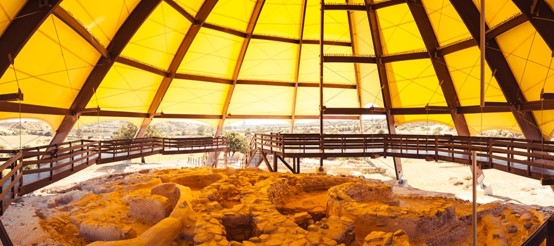
The Neolithic Age settlement of Tenta is situated a short distance from Kalavasos village and dates to 7000 BC. It is one of the most significant Neolithic settlements on the island, and is covered by a characteristic cone-shaped roof, which forms a contemporary architectural intervention in the landscape.
According to local tradition, the name of the site goes back to 327 AD when St. Helen – the mother of Constantine the Great – stayed in a tent (‘tenta’) in this location during her visit to the island following the discovery of the Holy Cross in Jerusalem.
Kition Archaeological Site
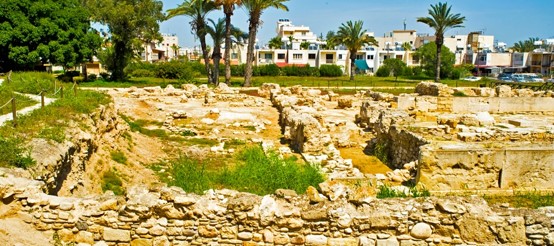
The architectural ruins of the ancient city-kingdom of Kition provide the first clear evidence that the Mycenaean Achaeans arrived in Larnaka (Larnaca) in the 13th century BC and stayed until the end of the 11th century BC. The Phoenicians inhabited the city in the 9th century BC. Around the end of the 13th century, Mycenaean Achaeans fortified the city with cyclopean walls made of giant blocks of limestone. Later on, the Phoenicians settled in the area in the 9th century, and built the temple of Astarte, Goddess of Fertility, related with the worship of Goddess Aphrodite. In 312BC, Kition was originally occupied and then destroyed by Ptolemy 1st Soter (the Egyptian Pharaoh). In spite of this, habitation continued into Christian times.
Kition was well known for its harbour in antiquity, from which many agricultural products were exported to the eastern Mediterranean, Egypt and the Aegean. Moreover, its strategic position rendered it an exceptional naval base. Of particular interest at the ancient port are the drawings of ships etched into the walls of buildings.
The most interesting architectural remains are those of the Temple of Aphrodite-Astarte, built by the same Phoenician masons that built the Temple of Solomon in Jerusalem, both originating in the 9th century BC. Egyptian-style temples of the 18th Egyptian Dynasty – which are older than their Greek equivalents and served the pre-Hellenic Cypriot population – have also been found nearby. The site is one of the first that the Cyprus Department of Antiquities excavated, after the island gained its independence from British Rule in the early 1960’s, and is linked to the Aphrodite Cultural Route.
Larnaka (Larnaca) Medieval Castle
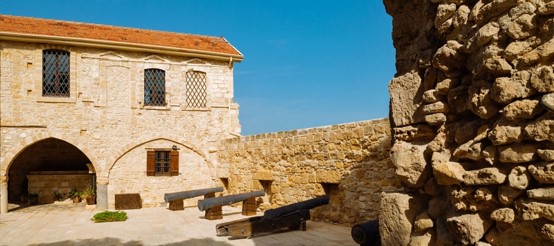
Located at the end of the Foinikoudes promenade, the Medieval Castle of Larnaka (Larnaca) (also referred to as Larnaka Fort) is believed to have been originally built during the Middle Ages, and took its present form during the Ottoman rule, although there is some contestation of its origins. Chronographer Florius Boustronius dates it to the years of Lusignan King James I (1382 – 1398 AD), who built it to protect the harbour of the town. During the same time, the Genovese occupied Famagusta (Ammochostos) and the Lusignans had to develop another major port for the needs of their kingdom. Sources from the 18th century insist that the castle was built by the Turks in 1625 AD, even though a Turkish garrison was stationed there since 1570 AD. Other references by travellers confirm that the castle was constructed before 1625. After the end of the Ottoman era in Cyprus, the British converted it into a prison and it was used during the first years of their rule. The western chamber of the ground floor in the east was used for the execution of prisoners. The gallows – which must had been constructed in the room – were in use until 1948.
Today, the castle houses the small Larnaka Medieval Museum across three rooms, and exhibits artefacts from the Early Christian period (4th-7th centuries) to the Ottoman period (18th-19th century).
Royal Chapel of Agia Aikaterini (St. Catherine) – Pyrga village
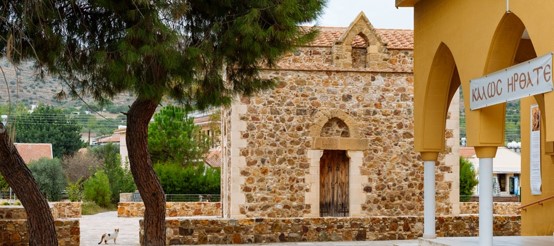
Considered to be one of the most interesting surviving structures from the Frankish Period on the island, the Royal Chapel was built in 1421 by the Lusignan King Janus.
The building is a small, single-aisled vaulted structure without an apse. In the past a portico enclosed the chapel on all sides (except for the east side). Up to the end of the 19th century, the ruins of a manor house or a monastery attached to the chapel were visible. Today only traces of these survive.
The chapel was originally entirely painted, but many of the paintings were destroyed during the course of time. On the eastern façade, King Janus is depicted in a wall painting, along with his second wife, Charlotte de Bourbon. The couple are kneeling in front of the Crucifixion cross, whilst another figure kneeling by the feet of Jesus at the scene of the Entombment is believed to be Hugh Lusignan, brother of Janus and Latin Bishop of Nicosia (Lefkosia).
Included in the mural decoration of the chapel is a series of coats-of-arms of the Medieval Kingdom of Cyprus, as well as graffiti carved into the frescoed walls. The graffiti belongs to various pilgrims and travellers, and the dates carved with them fall within the period between the 15th and the 16th centuries.
Stavrovouni Monastery
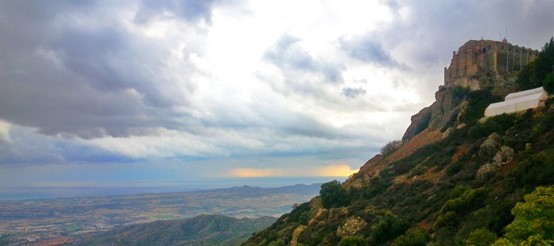
Perched on a rocky peak, 750 metres above sea level, legend tells that Stavrovouni Monastery was founded in the 4th century by St. Helena, mother of Emperor Constantine the Great, who left a relic of the Holy Cross at the monastery. The monks have strict rules akin to those at Mount Athos in Greece. Women are not permitted to enter the monastery, nor is the use of camera or video permitted. Men visiting must be appropriately dressed. In contrast, the monastery of Agia Varvara on the foothills of Stavrovouni is accessible to all visitors, and the monks here are known for their iconography skills. An impressive annual ceremony and festival is held at Stavrovouni Monastery on September 14 to mark the day of the Raising of the Holy Cross.
Terra Santa Catholic Church
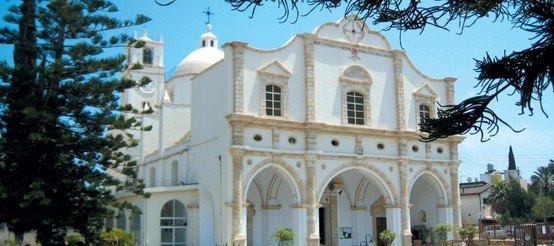
Terra Santa is the church of the Latin community of Larnaka (Larnaca) and is also known as Santa Maria delle Grazie. The architectural style of the convent combines impressive Renaissance and Baroque characteristics. Franciscan monk Callixte Martel founded the church and the convent in 1596, mainly to house Latin pilgrims visiting the Holy Land. In 1724, a larger church and convent replaced the original buildings, which in turn were demolished in 1842 to be replaced by the present church structures. The Catholic nuns of Italian origin at the convent have a long tradition of philanthropic services to the community of the town. They currently run an old people’s home on the church grounds.
Tuzla Mosque

Situated in the old part of town, behind the ruins of ancient Kition, Tuzla Mosque is one of the oldest mosques in Larnaka (Larnaca), and dates back to Byzantine times.
The mosque was originally a Byzantine Orthodox Church, as can be seen by the wall paintings in the building. In the 12th or 13th century it became the Catholic Church of the Holy Cross and was turned into a mosque after the Ottoman occupation of 1571. The minaret is built on the foundations of the original bell tower. Opposite the mosque is a well-preserved Venetian period public water fountain.
Zuhuri Mosque
Zuhuri Mosque lies between the Kebir (Buyuk) Mosque and the Church of Agios Lazaros. It was built in the middle of the 19th century and is an important Muslim religious centre. Its minaret collapsed in the 20th century.
Agios Georgios Makris Chapel
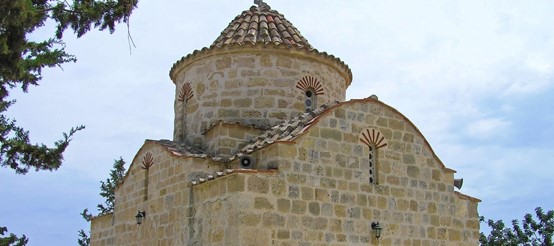
Built on a small hill that overlooks the area of the Salt Lake, the quaint stone-built chapel of Agios Georgios dates back to the 13th century when it was the church of the Medieval village of Agrinou, and serves as a miniature piece of late Byzantine architecture. The village and the church were destroyed by the Egyptian Mameluks, who invaded in 1426 and also captured the Lusignan King Janos. The church was soon repaired and the king was freed, but an annual tax was paid to the Mameluks until the Ottoman occupation. The church served as a monastery in the 18th-19th centuries, but the annexed structures were demolished in the 20th century, thus restoring the original setting of the church. A wall painting of the saint still survives on the north wall.
Kamares Aqueduct

This beautiful 18th century aqueduct can be found on the road heading towards Lemesos (Limassol) in the area of Kamares, which takes its name from the distinctive arches (‘kamares’ in Greek).
An open-air sight, the aqueduct was built in the Roman style in 1746 by the Turkish governor of Larnaka, Bekir Pasha, who funded it out of his own sources to carry water to Larnaka (Larnaca) from a source about 10 km away. The aqueduct was abandoned in 1939 and its function replaced by modern pipes. There are more than 20 arches still intact, and these are strikingly illuminated at night. A cobbled area with benches and a footpath allow you to enjoy the site of this monument, with the path linking up with Larnaka Salt Lake.
Agios Ioannis (St John’s) Cathedral
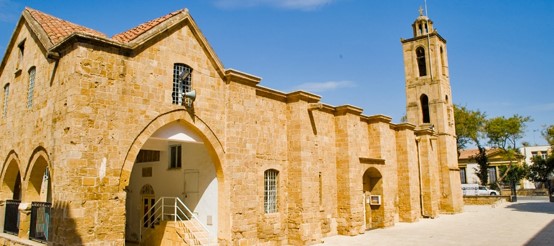
Agios Ioannis, within the walled city of Lefkosia (Nicosia), is built on the site of the 14th century chapel of the Benedictine Abbey of Agios Ioannis, the Evangelist of Bibi.
Archbishop Nikiforos rebuilt the monastery chapel from its foundations in 1662. Dedicated to Agios Ioannis the Theologian, it remained a monastery until the 18th century when Archbishop Sylvester converted it into a cathedral, establishing it as the seat of the Orthodox Archbishopric in Cyprus. The church is small, single-aisled and barrel vaulted, in the Franco-Byzantine style, with external buttresses and a west portico. In contrast to the deliberately modest exterior that was required by Ottoman rule, the gilded woodwork and bright interior illuminated by crystal chandeliers is particularly ornate. Covered in gold leaf, the woodcarving is in the best tradition of 18th century Cypriot craftsmanship, and it remains the only church in Lefkosia in which the whole of the internal Frescoes have survived in their entirety. The four large icons on the iconostasis were painted by the Cretan master, Ioannis Kornaros in 1795 and 1797, and the 18th century wall paintings depict scenes from the Bible and the discovery of the tomb of Agios Varnavas (St. Barnabas) at Salamis.
Archangelos Michael Convent
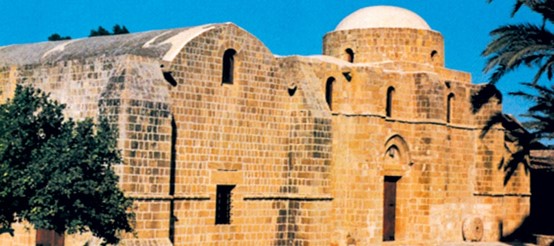
Located along the Lefkosia (Nicosia) – Anthoupolis Road, the church of the convent dates back to the Byzantine period and was founded by Archbishop Nikiforos, whose tomb can be seen in the narthex of the church. It was rebuilt in 1636 and was ceded to Kykkos Monastery in 1713. The iconostasis dates back to 1650, whilst the convent has a 1785 fresco depicting the Archangel Michael (Archangelos Michael) whom it is dedicated to. Today the convent houses the Kykkos Monastery Research Centre.
Archbishop’s Palace
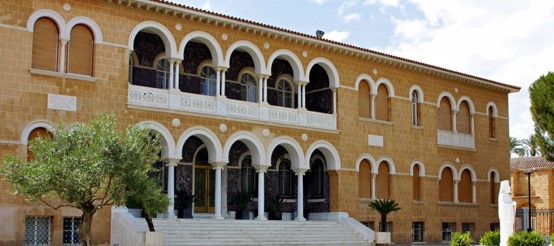
The New Archbishopric – the seat of the Cyprus Orthodox Church – was built in 1960 in a Neo-Byzantine style and contains the private suite of the late Archbishop Makarios III. The Old Archbishopric that stands alongside it was built in 1730 and houses the Ethnographic Museum of Cyprus on its ground floor.
Bayraktar Mosque
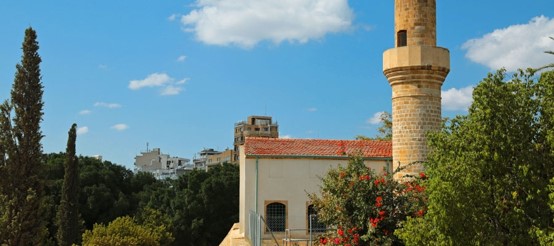
Located next to OCHI Market, this Ottoman mosque is built on the western end of Constanza Bastion, in honour of the flag carrier who first climbed on to the walls of Lefkosia (Nicosia) during the siege of the city by the Ottoman troops in 1570. Its name derives from the Turkish word ‘bayrak’, meaning ‘flag’ or ‘military trophy’, with the flag carrier’s grave built on the spot later in 1764. The mosque itself dates back to 1820, and was restored and opened for worship in late 2003.
Faneromeni Church

Located within the walled city of Lefkosia (Nicosia) on Onasagorou Street, Faneromeni Church is one of the largest churches of the capital, and was built in 1872. The marble mausoleum to the east of the church contains the relics of the bishops and priests executed by the Ottomans on July 09, 1821. Opposite the church is Faneromeni School, one of the most historic academic institutions on the island.
Hamam Omeriye
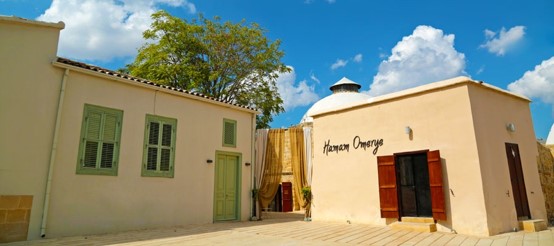
The Hamam Omeriye (Turkish) baths were built in the 16th century by Lala Mustafa Pasha as a gift to the city, with the bath complex dedicated to the Caliph Omer, giving the area its name of ‘Omeriye’. After a long period of closure, the baths were once again restored to their original glory, earning them the ‘Europa Nostra’ award in 2005, and are open to the public for steam baths and other treatments. As is typical with Ottoman baths, there are three main areas: the changing and resting room that leads to the warm and hot chambers via an intermediate tepid area. In ancient times, exposure to hot and humid conditions was a prized remedy for general health and formed part of a cleansing ritual.
Holy Cross Catholic Church
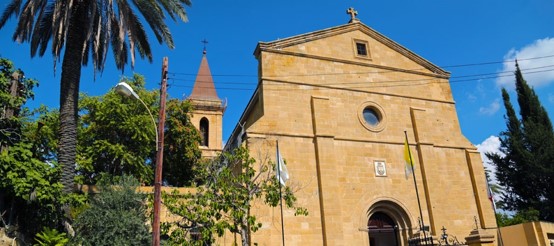
The Church of the Holy Cross, built in 1902, is situated near Pafos Gate, one of the three entrances into the town through the Venetian walls surrounding Lefkosia (Nicosia). The church does not belong to any definite architectural style, and its features are austere. A rose window (decorated circular window) with the cross of Jerusalem in stained glass can be seen in the façade, whilst below the rose window, there is the coat-of-arms of the Custody of the Holy Land.
Ancient Idalion Archaeological Site
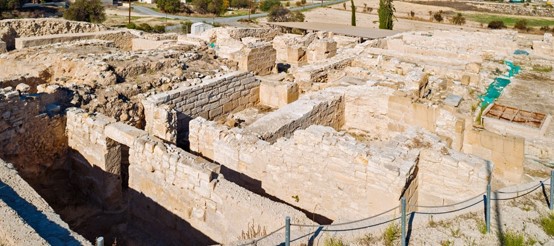
The archaeological site of Idalion, in the Dali Village area, is one of the most important sites in Cyprus, with many of its rich findings now exhibited in some of the most renown museums of the world. The ancient city was founded by the Achaean hero of the Trojan war, Chalcanor – descendant of Teucer, the founder of Salamis. According to legend, Ancient Idalion is where Adonis – Aphrodite’s lover – was killed by her jealous lover Aris, the Olympian God of War. The kingdom flourished until the middle of the 5th century BC, when its capital was besieged and captured by the Phoenician kings of Kition. Finds have been unearthed from both settlements and cemeteries in the region, with the earliest remains of human occupation found at the locality of Agridi, dating back to the 7th and 5th centuries BC. The site houses a museum and Visitor Centre, which showcase its finds, and is also linked with the Aphrodite Cultural Route.
Saint George’s Church – Lazanias village
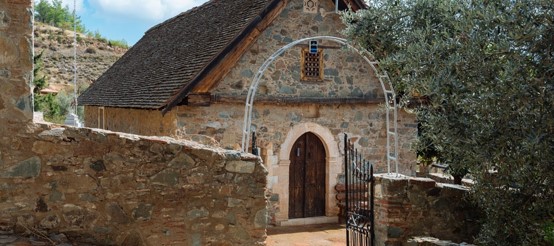
The wood-carved church of Saint George is located in the historic village of Lazanias and was built in 1855.
An inscription inside the church gives testimony that on April 27, 1865, a priestmonk gilded the iconostasis at his own expense. Also of interest are the artfully carved ‘gynaeconitis’ (area reserved for women), and the three earthenware jars that are planted on the floor of the church, and were used for better acoustics during Mass. An unusual vegetal decoration trails over the roof and decorates it.
The village itself takes its name from the word ‘Lusignan’ thanks to a farm of the Lusignan Crusaders that formed the basis of the village.
Omeriye Mosque
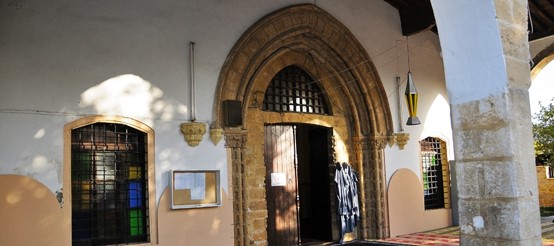
The Omeriye Mosque was once the medieval Augustinian monastery of St. Marie, built in the 14th century, and one of the three largest monasteries in the city during the Lusignan era. It originally covered an area of six acres, which included gardens, orchards, a field of wheat and barley, and a sugar plantation. In 1571, the monastery was converted to a mosque by Lala Mustafa Pasha – the Ottoman conqueror of the island – who believed that the original church was built on the spot where the Caliph Omer rested when visiting Lefkosia. Most of the original building was destroyed by Turkish artillery in 1570, and inscribed tombstones from the Lusignan period were used to install a new floor for the mosque.
Pafos (Paphos) Gate

Pafos (Paphos) Gate was one of the three entrances into old Lefkosia (Nicosia) through the Venetian walls that completely encircled the old city, and were designed by famous engineer Giulio Savorgnano in 1567. The road beginning immediately outside the gate led southwest to the town of Pafos, hence the gate’s name. It was also known as ‘Gate of San Domenico’ as it replaced an earlier gate of the Frankish walls called ‘Porta di San Domenico’, named after the nearby abbey of San Domenico. The gate is a simple affair; an opening in the wall, roofed by a barrel vault. During British occupation in 1878, part of the walls between the gate and the Roccas Bastion was demolished to create a new opening. Pafos Gate Police Station is just above the original gate.
Panagia Chrysospiliotissa Church
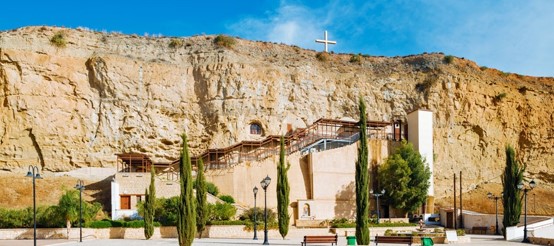
Located near Kato Deftera village, 11km southwest of Lefkosia (Nicosia), the church ‘Our Lady of the Golden Cave’ (dedicated to the Virgin Mary) is believed to date back to the early Christian period, and the shape of this small church inside a cave is very rare in Cyprus.
Sadly, the decorated walls of the cave have suffered great damage and the frescoes are no longer visible, but a large religious festival is held on August 15, the day of the Dormition of the Virgin Mary.
Tamasos Archaeological Site
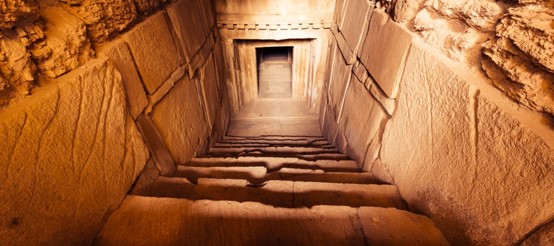
Tamasos was one of the most important city kingdoms of Cyprus, even though the exact date of its establishment and its founder are not known.
Located on the left bank of the river Pediaios, in the area where the villages of Politiko, Pera and Episkopio are found today, the large archaeological site has unearthed the temple of Aphrodite, two majestic royal tombs, as well as several smaller ones. Part of the city’s fortifications and copper-processing installations can also be seen at the site, whilst excavations have also brought to light copper workshops associated with Aphrodite – Astarte, and six oversized limestone statues dating back to the 6th century BC, when Cyprus was under Egyptian rule. The latter are now exhibited in the Cyprus Archaeological Museum in Lefkosia (Nicosia). The Cult of Aphrodite flourished at the site, as indicated by the altar made of rough limestone, as well as various votive vessels, incense burners and lamps that have been unearthed. The sanctuary and the altar are thought to have been built during the Cypro – Archaic II period (600 – 475 BC), destroyed at the beginning of the 5th century, and again in the 4th century BC, only to have been rebuilt during the Hellenistic period. Terracotta and stone statuettes of pigeons (the bird sacred to Aphrodite) have also been uncovered.
Famagusta Gate (Pyli Ammochostou)

Famagusta Gate (Pyli Ammochostou) is the largest of the three entrances into old Lefkosia through the Venetian walls that completely encircled the old city, and were designed by famous engineer Giulio Savorgnano in 1567. Originally known as ‘Porta Giuliana’ – the eastern gate of the walls – it was later renamed ‘Famagusta Gate’ as the gate opened onto the road that led to the most important harbour town of the island at the time, that of Famagusta. Famagusta Gate has since been restored and the Nicosia Municipal Multicultural Centre now operates within the large vaulted passage and its two adjacent rooms. The internal entrance is very impressive, whilst the external one opens onto the moat that surrounds the walls.
The Archontiko of Axiothea

The Archontiko (Mansion) of Axiothea, located in the old town of Lefkosia (Nicosia), is one of the most characteristic examples of urban architecture of the 18th century.
The two-storey building was built in the shape of the Greek letter ‘pi’ (Π), with a north-south orientation, and originally occupied a much larger area. The main entrance is located on the east side of the house, which leads to the inner courtyard. On the west and south side is a portico defined by a row of arches that separates the courtyard from the rooms that surround it. There are three big halls, two smaller rooms and two auxiliary rooms on the ground floor, with three more halls and two smaller rooms on the upper floor.
Today, the mansion serves as a centre for cultural activities, exhibitions and literary seminars for the University of Cyprus.
The Medieval Walls of Lefkosia (Nicosia)
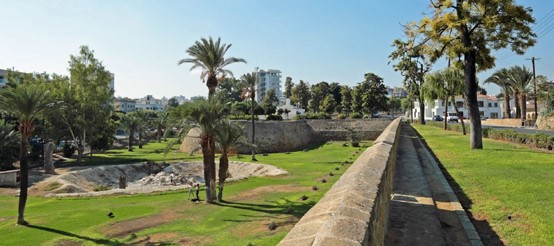
The Medieval Walls that still surround the old city of Lefkosia (Nicosia) were built by the Venetians in the 16th century. Forming a circle, the walls are fortified by eleven heart-shaped bastions and protected by an 80-metre wide moat. They were built of mud brick, with only the lower part buttressed by stone. When the Ottomans occupied Lefkosia, they repaired the walls and covered the upper part with stones. The original walls were built in the 14th century by the Franks and enclosed a much larger area. When the Venetians occupied Cyprus, they decided to demolish the Frankish walls as their old age meant that they did not offer adequate defences against new weapons of the time, such as artillery. The Frankish walls were also too big to be manned by the Venetian army, and too close to the hills in the east and southeast of the city. Today, the moat around the walls has many different uses – as sports fields, public gardens, an open-air sculpture exhibition, car park, and other uses.
Archangelos Michael Trypiotis Church
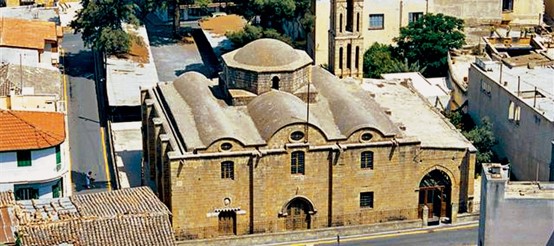
Built by Archbishop Germanos II in 1695, the Church of Archangelos Michael Trypiotis in old Lefkosia (Nicosia) is an excellent example of Franco-Byzantine style architecture, with three naves and a dome that almost has the aspect of a square. Built with attractive, smoothed calcarenite stone that holds a rich interior, the church contains an outstanding icon influenced by an Italian painting of the 15th century, and other silver icons from the period of Ottoman Rule, as well as possessing an unusually wide iconostasis.
According to an inscription to the east of the south entrance, the church was built at the expense of the Priest Iakovos and Christian parishioners in 1695 during Ottoman Rule.
St. Paul’s Anglican Church
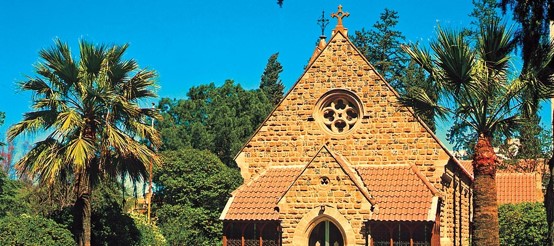
The church of St. Paul was built in 1893 when Cyprus was a protectorate of the British Empire. The influence of politics on architecture is evident by the structural elements of the building, which is reminiscent of an English parish church. The Christian church today is part of the Diocese of Cyprus and the Gulf.
Agios Irakleidios Convent
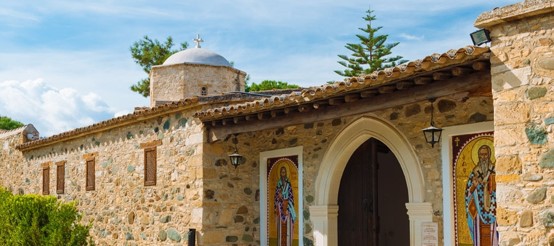
Irakleidios, the son of a pagan priest, was ordained Bishop of Tamasos by Saints Paul and Barnabas. He was martyred at the age of 60 and buried in the cave where he had lived, and from where he preached the Gospel. In 400 AD a church was built over his grave.
The monastery was destroyed and rebuilt several times. Today’s buildings date back to 1773 when Archbishop Chrysanthos restored the church and convent cells. The saint’s relics are kept inside the church. Today the monastery functions as a convent.
Church of Agios Varnavas and Ilarionas (Saints Barnabas and Hilarion)
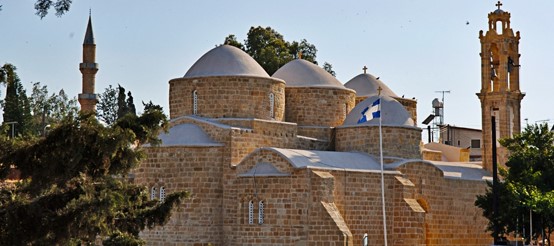
Located in the village of Peristerona, on the west bank of Serrahis tributary river, the church dedicated to Saints Barnabas and Hilarion is thought to have been built in the 9th or 10th century. The five-domed building serves as an outstanding example of Cypriot Byzantine architecture, with part of the original church’s north wall still surviving and incorporated in the western part of the wall of the existing church. The oldest wall-painting samples belong to the 15th and 16th centuries. Next to the church lies the Turkish mosque of Peristerona, and the image of the two side-by-side has appeared on past currency and stamps as a symbol of peaceful coexistence between Greek and Turkish Cypriots prior to the 1974 Turkish invasion.
Agios Panteleimon Convent

The 18th century convent of Agios Panteleimon, with its gabled roof, is located in the Achera Valley, northwest of the Lefkosia (Nicosia) district at the village of Agrokipia.
The original old monastery complex consisted of the main church and buildings standing in the northern and eastern side, while the ground floor of the northern part of the church was divided into storage rooms, a laundry room, rooms with gyles and ovens, as well as a room where sweets were produced. There are no remains of the old church, or the original buildings of the monastery. According to an inscription located at the west entrance of the church, it was renovated in 1770, three years after Archbishop Chrysanthos was enthroned. The iconostasis was gilded, whilst icons of Jesus Christ, Virgin Mary, Agios Panteleimon and Agios Nicolaos were painted at the same time by the painters Michalis Thetallos or Thesalonikeas.
The monastery played an important humanitarian role for the island during the National Liberation Struggle and the Turkish invasion of 1974. It was restored shortly after 1960, and in 1989 another annex was added to the southern part of the building. Today the monastery functions as a convent.
Panagia Chrysaliniotissa Church
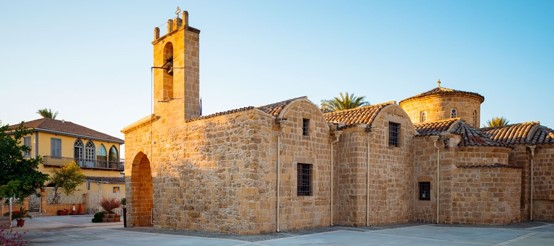
Dedicated to Panagia Chrysaliniotissa (Our Lady of the Golden Flax), this church is believed to be the oldest Byzantine church in Lefkosia (Nicosia), and thought to have been first built in 1450 by Queen Helena Palaeologina. The church is renowned for its rich collection of old and rare icons, and the street it is located on, within the walled city of Lefkosia, was named in its honour (Chrysaliniotissa Street).
Chrysaliniotissa Crafts Centre
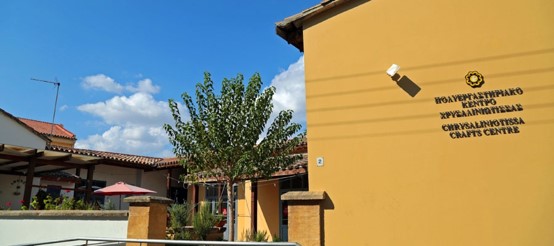
This complex of eight workshops is situated near Panagia Chrysaliniotissa Church (Our Lady of the Golden Flax) – the oldest Byzantine church in Lefkosia (Nicosia). The workshops nestle around a central courtyard in the manner of a traditional inn, and consist of various units engaged in contemporary applications of traditional crafts, along with a coffee shop. The Crafts Centre is part of an ongoing project to restore and regenerate the old part of Lefkosia within the walls.
Laïki Geitonia (Traditional Neighbourhood)
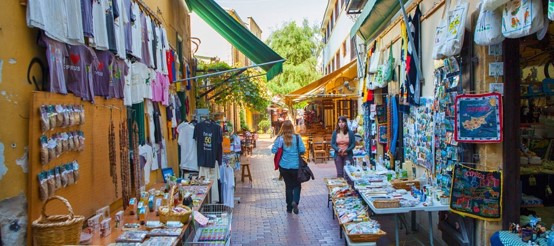
Laïki Geitonia is a traditional pedestrian neighbourhood inside the walled city of Lefkosia (Nicosia), with buildings that date back to the 18th century and serve as typical examples of traditional Cypriot urban architecture. The buildings are now used as residences, shops, tavernas and craft centres, having been restored and preserved. The popular neighbourhood area is located 200 metres east of Plateia Eleftherias and is ideal for exploring on foot.
Ledra Museum – Observatory
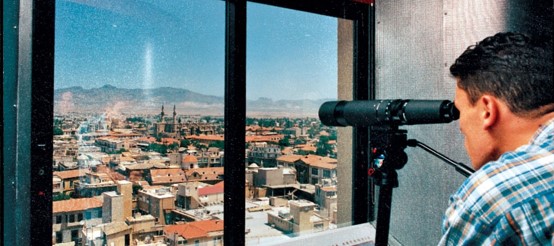
The observatory on the 11th floor of the Shakolas Tower – one of the tallest buildings on the island – provides a panoramic view of the whole town of Lefkosia (Nicosia). Visitors can admire unobstructed all-round views of the city and its landmarks. The museum itself opened in 1998 and shows an exhibition of photographs and descriptions of Old Lefkosia in cooperation with the Leventis Museum of Lefkosia, with a multilingual taped history, touch screens and telescopes.
The Old Carob Mill
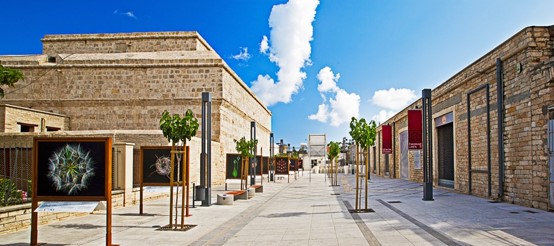
The Old Carob Mill was built in 1900, at a time when carobs were a major export of the island, and were used to make a wide variety of products such as photographic film plates, medicines, sweets and chocolates. Divided into a complex of two distinct areas, the first area consists of the restored Carob Mill – where the machinery used in processing the carobs is preserved and displayed – and the second area houses the Evagoras Lanitis Centre – an arts and exhibition area.
Agios Nikolaos ton Gaton Convent – St. Nicholas of the Cats Convent

Located on Cape Gata, 15km west of Lemesos (Limassol) and south-east of Akrotiri Salt Lake, the monastery of Agios Nikolaos ton Gaton (St. Nicholas of the Cats) is possibly the oldest monastery in Cyprus. The monastery chapel dates back to the 14th century and was abandoned in the 16th century. It was reinstated by Orthodox nuns in 1983.
According to tradition, the monastery was founded by St. Helena, the mother of Emperor Constantine the Great, who left a piece of wood from the Holy Cross at the site. During that period, Cyprus experienced a severe drought, forcing many people to flee the cape and the area became infested by snakes.
Constantine the Great sent a commander called Kalokeros to Cyprus to release thousands of cats in order to rid the area of the snakes, and thus the cape was saved and came to be known as Cape Gata (Cape Cat). Whilst the monastery has just a handful of nuns now, there are many cats, which are said to be the descendants of those who rid the area of snakes.
Amathous Archaeological Site

Amathous is one of the significant ancient city-kingdoms of Cyprus where, according to mythology, Greek hero Theseus left the pregnant Ariadne to be attended by local women. It was also an important site of worship of the Goddess Aphrodite-Astarte. There are various, rich archaeological finds at the site, including the Agora, the public baths, the Temple of Aphrodite, early Christian basilicas and several tombs. The Agora is located in the lower town. In ancient times, it was the traditional hub for commercial and political activities, and the many buildings surrounding it, played an important role in the daily life of the city. During the Roman period, the Agora was organised around a large stone-paved court. Three porticos occupy the other three sides. The west portico opened to the court through 13 Doric columns, and ended at its north edge at a fountain (or a Nympheum), and at a later cistern. Buildings were erected behind the north portico – which is very damaged – and appear to have constituted the most important administrative or religious buildings of the site. The area south of the Agora is occupied by a public bath (balaneion), which is comprised of a closed circular area and annexes. The bath – along with part of the west portico of the Agora – date to the Hellenistic period, and constitute the earliest indications of human activity in the area. Also at the site is the Temple of Aphrodite, sat atop of a hill at the Acropolis of Amathous. Evidence of the presence of a sanctuary in the area includes votive offerings going back to the mid 8th century BC. Through the centuries, the Temple of Aphrodite was a sacred enclosed space for ceremonies and votive offerings around an altar. There may have been other buildings in the area, but the cult itself was not housed in a main building. Two gigantic stone craters (huge monolith vessels) – believed to be of the late Archaic period stood in the area. One was taken to the Paris Louvre in the middle of the 19th century and has now been replaced by a modern replica. It is also believed that there were two other temples at the Acropolis of Amathous – one dedicated to Adonis and the other to Hercules. Finds also originate from several tombs and date from the Archaic to the Roman and Christian periods, were found at the Acropolis and the lower section of the town, and in five early Christian basilicas. The site is also linked to the Aphrodite Cultural Route.
Amathous Harbour
Amathous is one of the ancient city-kingdoms of Cyprus where, according to mythology, Greek hero Theseus left the pregnant Ariadne to be attended by local women. It was also an important site of worship of the Goddess Aphrodite-Astarte. Amathous Harbour was constructed during the Hellenistic period by Demetrios Poliorketes and consisted of two parts; the outer and the inner port. The outer port measured around 100 metres by 180 metres and was delineated by wharves in the east and a breakwater in the south. Access was through an opening on the east wharf. The port had a short lifespan as it soon silted up and the sea level dropped. The inner port stood behind the outer port and was where mariners moored their ships in order to protect them from bad weather. It was abandoned quite early on due to the outer port silting up. By the 3rd century BC, the harbour was used only by fishermen, and by the 1st century AD, it was completely dry. Today it lies below sea level, but is easy to distinguish.
Central Municipal Market of Lemesos (Limassol)

The Central Municipal Market of Lemesos (Limassol) – located in the old town – is a large, stone built structure, consisting of big halls and shops occupying an area of 3.000 square metres. It was built in 1917, but took its present form in 1947, and is now a listed building. Up until the 1970s, the market and the surrounding shops constituted the centre of trade and other commercial and social activities of the town, but thereafter, its use began to decline due to the rapid expansion of the city, and the creation of new shopping areas. Today, the market is seeing resurgence and once again becoming part of daily life, providing a traditional experience of shopping in a bustling and friendly environment. Aside from the fresh, local Cypriot produce of fruit, vegetables and meat, there is also a bakery, a traditional coffee shop ‘kafenion’, and an array of unique handicraft items and other products.
Kolossi Medieval Castle
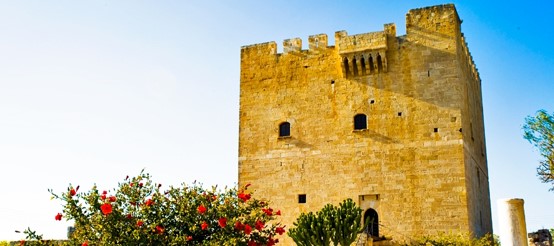
Serving as a fine example of military architecture, Kolossi castle was originally built in the 13th century, and rebuilt in its present form in the 15th century. After the fall of Acre in 1291, it served as the Grand Commandery of the Knights of the Order of St. John of Jerusalem, and in the 14th century came under the domain of the Knights Templar. During their stay in Cyprus, the Knights produced and exported a sweet wine, which became known as the ‘vin de Commanderie’. Today, Commandaria wine is one of the island’s traditional wines and one of the oldest named wines in the world, having had the same name for eight centuries. Next to the castle are the ruins of a 14th century sugar mill.
Kourion Archaeological Site
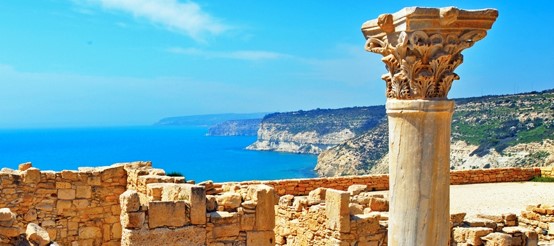
The archaeological remains of Kourion – which was one of the island’s most important city-kingdoms in antiquity – are of the most impressive on the island, and excavations have unearthed many significant finds, which can be viewed at the site. The city-kingdom was built on the hills of the area, and overlooked and controlled the fertile valley of the river Kouris. According to archaeological finds, evidence suggests that Kourion was associated with the Greek legend of Argos of Peloponnese, and that its inhabitants believed they were descendents of Argean immigrants. The once-flourishing kingdom was eventually destroyed in a severe earthquake in 365 AD. The magnificent Greco-Roman theatre – the site’s centrepiece – was built in the 2nd century BC and extended in the 2nd century AD. The theatre has been restored, and is now used for open-air musical and theatrical performances – mainly during the summer months – making it one of the most popular settings for high-calibre cultural events. East of the theatre are the remains of a prominent building, the ‘House of Eustolios’, which was originally a private villa that was turned into a public recreation centre during the Early Christian period. Whilst the villa was modest in size, it was well equipped and richly adorned. Its remains consist of four panels of beautiful, 5th century mosaic floors in the central room, and a bathing complex that is located on a higher level, accessed by steps, north of the building. A roof structure allows visitors to enjoy the site all year round, and explore its remnants. The baths themselves originally opened off the central room to the north and east, where there were cold baths (frigidarium). Before each is a shallow foot-bath; while on the west, the remains of the hypocausts – which heated the medium room (tepidarium), and the hot room (caldarium) – can be seen. In the latter, the built-in basins for hot baths have survived, as have the firing chambers, where hot air was carried through the hypocausts, travelling up through specially-cut flues, through the walls, and beneath the terracotta tiles of the floor.
Along with the House of Eustolios, there are further impressive mosaic floors in the ‘House of Achilles’ and the ‘House of the Gladiators’, with the villas named after the scenes depicted on the mosaics. The remains of the Roman Agora are also visible at the site. The structure dates back to the early 3rd century, with additions made later on, during the Early Christian period. The Roman Agora is built on the remains of an earlier public building, which was in use from the end of the 4th century to the end of Hellenistic period.
The Agora of the city is surrounded by porticos with marble columns on both sides, whilst on its northwest side, is an impressive public bath and a small temple, the Nymphaeum, dedicated to the water nymphs. An early Christian basilica at the site dates back to the 5th century, with separate baptistery on the external northern side. The Stadium of Kourion lies 1km to the west, on the right side of the road towards Pafos.
Kourion Mosaics
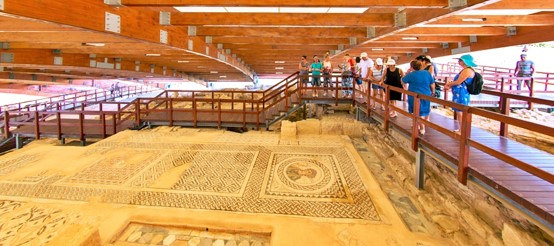
Kourion was an important city-kingdom in antiquity and stands as one of the most impressive archaeological sites in Cyprus, where well-preserved mosaics decorate the floors of its stately villas.
The Baths and the House of Eustolios Located east of the theatre is the House of Eustolios, which probably dates to the early 5th century AD, and takes its name from an inscription citing Eustolios as the builder. A mosaic with a welcoming inscription graces the antechamber of the entrance, whilst there are mosaic decorations in three of the porticoes and a bath complex to the north. The house is believed to have been originally built as a residence and was probably opened to the public after the construction of the baths and the addition of the mosaic floors.
House of Gladiators
One of the most notable villas, which dates back to the second half of the 3rd century AD, is the House of Gladiators. It takes its name from a series of mosaics near its main courtyard representing gladiatorial combats. The central part of the house was an atrium. Entrance was through a stairway on the northeast corner which opened onto another, smaller atrium joined to the central one by a corridor. The southern part of the building was destroyed, probably due to earthquakes in the 4th century AD. To the east of the corridor is a typical bath complex.
House of Achilles
Consisting of an open courtyard with rooms on two sides and a portico, the 4th century AD House of Achilles takes its name from the mosaic of the legendary Greek hero. The residence was most likely used to receive official guests, whilst the house has other mosaic floors.
Lemesos (Limassol) Medieval Castle
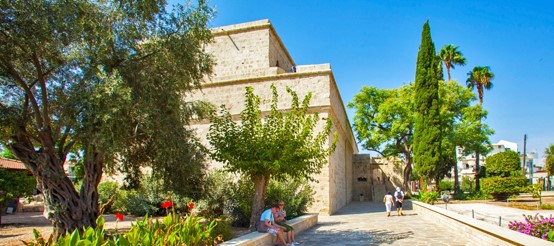
Lemesos (Limassol) Medieval Castle is situated in the heart of the old town, just above the old harbour. According to tradition, this is where Richard the Lionheart married Berengaria of Navarre and crowned her Queen of England in 1191. The fortified walls are of considerable archaeological interest and thought to be fragments of a much larger castle. The exact date of the fort’s construction is not known; according to Etienne de Lusignan, it was built in 1193 by the founder of the Lusignan dynasty, Guy de Lusignan, but the first official reference to the fort dates to 1228, during the involvement of Frederic II of Germany in the affairs of Cyprus. Throughout the years, the fort suffered the assaults of many invaders, sustaining further damage in the earthquakes of 1567 and 1568. Finally, in 1590, the Ottomans rebuilt the fort in its current form. The original fort was larger than the later one, which incorporates some parts of the former building, such as the two oblong halls of the ground floor. Below the eastern hall there is a basement with cells, which was used as a prison until 1950. Today, the fort houses the Medieval Museum of Cyprus.
Panagia tis Amasgou Monastery
Located in the Kouris Valley, the small Byzantine church of Panagia tis Amasgou Monastery is dedicated to the Virgin Mary.
The structure is single-aisled and barrel-vaulted with a second timber roof with hook-shaped roof tiles. The original church was built in the 12th century and is adorned with excellent 12th, 13th and 16th century wall paintings. All the surrounding buildings – with the exception of the western wing – are of a later date, and were built to serve the needs of the nuns that recently settled there.
St. Catherine’s Catholic Church
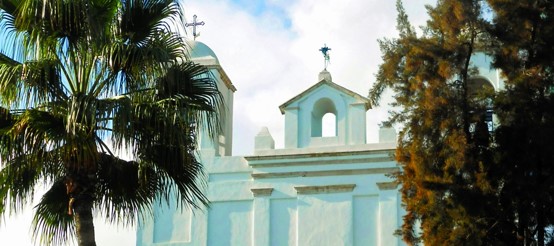
Built in 1879 by architect Friar Francesco da Monghidoro from Bologna, the church follows the architectural style for similar buildings of that period throughout Europe. The Friar used an interior baroque style, whilst opting for an eclectic design on the exterior facade. The walls on the apse and its vault are decorated with neo-Byzantine frescoes, which were repainted during renovations in 1979.
Sanctuary of Apollon Hylates
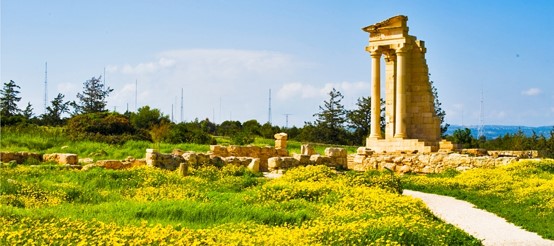
Apollon Hylates, God of the Woodland, was the protector of Kourion and it is believed that he was worshipped at the site from the 8th century BC to the 4th century AD. His sanctuary was an important religious centre and underwent many extensions and alterations in different periods. Originally, the site consisted of a temple (traces of which survive in the foundations of the present temple), a circular monument, and a formalized Archaic Altar and Precinct. During the Roman period the site was extended with the addition of the south and north buildings, which may have been used for the display of votives or the accommodation of visitors. Terracotta figurines and pottery that were accumulated in the temple from the 5th century BC to the Roman period were buried in the votive pit. The majority of the monuments – as they can be seen today – belong to the site’s 1st century AD restorations, and consist of Apollo’s temple (which has been partly restored), pilgrim halls, the ‘palaistra’ (where athletes exercised and played games), a bath complex, and a holy precinct.
Theatre of Kourion

Kourion was an important city-kingdom in antiquity and stands as one of the most impressive archaeological sites in Cyprus. Its theatre – located on the southern end of the abrupt hill on which the city is built – is of great significance. The theatre was constructed at the end of the 2nd century BC, but took its current dimensions during the 2nd century AD. Consisting of a semicircular orchestra that is surrounded by seats of the cavea (subterranean cells), it was enclosed to the south by the building of the scaenae frons (façade) that must have reached the height of the cavea, though today only the foundations remain. On either side of the stage were two vaulted parodoi (corridors) from where the audience entered the theatre. The theatre could seat up to 3,500 spectators. In the beginning of the 3rd century AD modifications were made, and the theatre was transformed into an arena that was used for fights with wild animals. At the end of the 3rd century AD, the arena spectacles declined and the theatre reassumed its proper purpose. Excavations began in 1933, conducted by the University of Pennsylvania, whilst many other University Archaeological Missions – as well as the Cyprus Department of Antiquities – continued the excavations. Today, it is the scene of many cultural activities and theatrical performances, especially during the summer season.
Church of Panagia Iamatiki
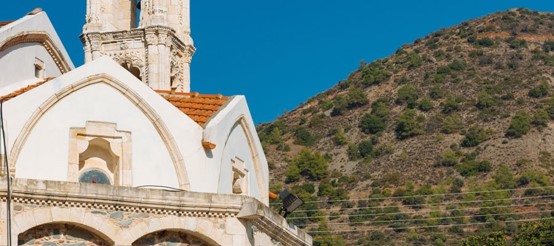
The Church of Panagia Iamatiki is situated on the outskirts of the village of Arakapas, and is a three-aisled wooden-roofed church. The church contains sophisticated wall paintings of the early 16th century that are among the most important surviving examples of the Italo-Byzantine style of art on the island. An extraordinary leather icon of the Virgin (in the nearby new church) is believed to have special curative powers.
Agios Georgios Alamanos Convent
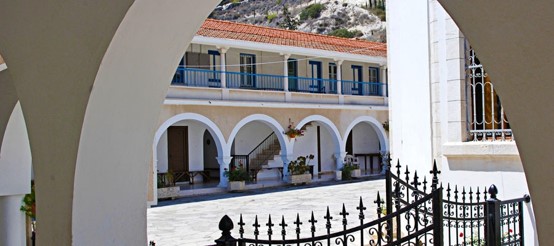
Located 20km east of Lemesos (Limassol) on the road to Nicosia (Lefkosia), Agios Georgios Alamanos was originally founded as a monastery in the 12th century, and now functions as a convent. Aside from performing their religious duties, the nuns pass their time with icon painting, the cultivation of flowers and herbs, and the production of honey.
Agia Anastasia Church
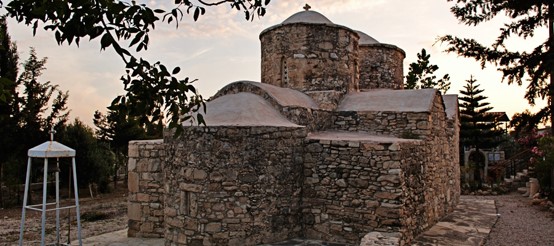
Agia Anastasia Church is a complex of two domed churches located in Polemidia village. The older church – possibly dating to the 12th century – is on the east side and is a cross-in-square domed church. The second church, on the west side, was added in the 14th century and built in the same architectural style. The surviving mural paintings date back to the 14th, 15th and 17th centuries.
Agia Napa Church, Lemesos (Limassol)
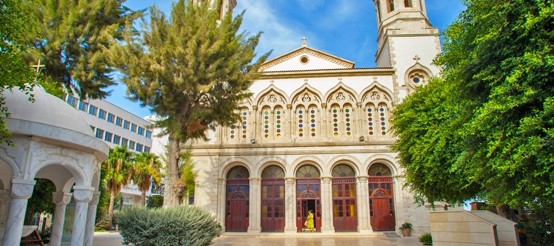
Located on Agiou Andreou Street, Agia Napa Church was built towards the end of the 19th century – early 20th century, on the ruins of an older, smaller Byzantine church.
According to tradition, the church takes its name from an icon of the Virgin Mary, which was found in a glen (‘napa’ in Latin), and thus is dedicated to her. Other sources believe that the church owes its name to a temple built in the Frankish period, dedicated to the Holy Nappe of St. Berenice, known by the name of ‘Saint Nape’. The present church – which was completed in 1906 – is three-aisled, with a marble iconostasis and frescoes mainly on the dome, and contains a silver-covered icon of Agia Napa.
Kebir Mosque (The Great Mosque) – Lemesos (Limassol)

Located in the old Turkish quarter, Kebir Mosque was built in the 16th century and is still operational today, making it one of the most important places of worship for the Moslems of Lemesos (Limassol). Recent excavations to the east have also revealed the architectural remains of the 10th century cathedral of Agia Ekaterini.
Kourion Stadium
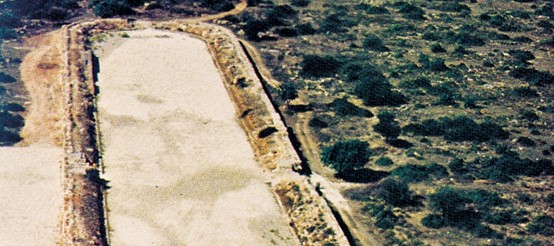
Kourion was an important city-kingdom in antiquity and stands as one of the most impressive archaeological sites in Cyprus.
Located 20km west of Lemesos (Limassol), on the road to Pafos (Paphos), Kourion Stadium is the only ancient stadium found in Cyprus. Dating back to the 2nd century, the stadium had a capacity for 6.000 spectators and was the site of pentathlon events in ancient times. The site is free admission.
Church of Timiou Stavrou (Holy Cross) – Anogyra
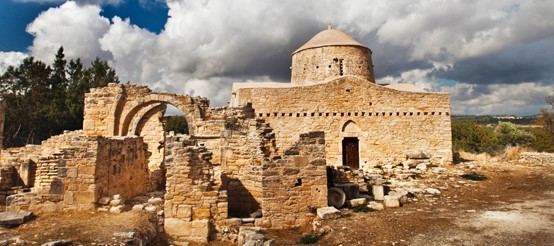
Situated southwest of the village of Anogyra, the Church of Timiou Stavrou is built over the foundations of an early Christian basilica. At the end of the 15th century, the present church was built overthe foundations of older churches. In its present form, the monastery is an intricate architectural complex. Its barrel-vaulted church with a single nave and dome is decorated with wall-paintings in the Palaiologan style which, despite marked wear and tear, remain exceptional examples of Palaiologan painting in Cyprus.
The village itself is located halfway between Lemesos (Limassol) and Pafos (Paphos), 400 metres above sea level, and retains its traditional character and local customs. Surrounded by carob orchards, the ‘black gold’ of the island and the traditional sweet made from it – ‘pasteli’ – are an important part of the village’s history.
Agia Paraskevi Byzantine Church – Geroskipou village
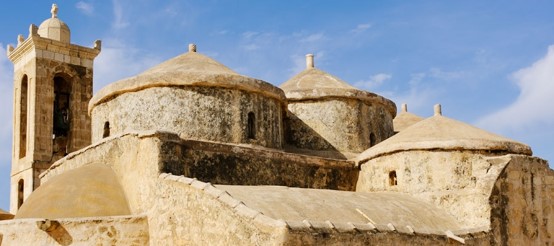
Located in the village of Geroskipou, this interesting 9th century Byzantine church is a five-domed, three-aisled, barrel-vaulted basilica, making it one of only two such churches on the whole island, and a significant example of Byzantine architecture. The beautiful interior wall paintings date to various periods, from the 8th-15th centuries. A monochrome reddish cross, painted directly on the stone, is of an earlier type and was revealed during restoration works. This type of cross is usually dated to the Early Christian period, up until the 8th-9th century.
Apart from its frescoes, the church also contains a rather significant portable, double-sided icon, dating to the 15th century. The Virgin Mary is depicted on one side, and the scene of the Crucifixion on the other. According to tradition, the name Geroskipou (‘sacred garden’ in Greek) derives from the sacred gardens of the Goddess Aphrodite, which were located to the south of the village towards the sea, at the point where the ancient pilgrims began their journey to the sanctuary of Palaipafos (old Pafos). As such, the church may stand on the ruins of an ancient temple dedicated to Aphrodite, although it could also originally have been dedicated to Timios Stavros (the Holy Cross). Today, it is dedicated to the Christian martyr Agia Paraskevi.
Agia Solomoni Christian Catacomb

Located in Kato Pafos (Paphos), Agia Solomoni Church is a chapel that forms part of a small underground complex of chamber tombs from the Hellenistic period. In Medieval times the site was a popular pilgrimage and has also been called ‘The Chapel of the Seven Sleepers’, or ‘The Seven Maccabees’. Agia Solomoni was one of the first to reject idolatry and embrace Christianity on the island. According to tradition, Solomoni took refuge in the cave to escape persecution from the Romans, but they walled up the entrance, condemning her to a slow and cruel death. However, when the cave was opened 200 years later, the saint walked out alive. The site consists of an open court, surrounded by five rock-cut chambers, one of which has a spring. The west chamber has an apse set into the west wall and remnants of 12th century Christian wall paintings. The names of 13th century Crusaders are among the graffiti cut into the plaster. Above the catacombs stands a sacred tree with its branches adorned by colourful rags and bits of clothing left by the faithful as offerings to the saint. It is believed that the tree has curative powers.
Agios Georgios Pegeia Archaeological Site
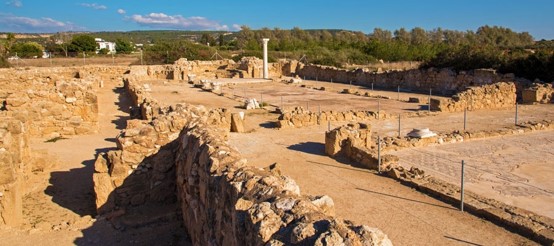
The archaeological site of Agios Georgios at the Pafos (Paphos) village of Pegeia is a famous place of pilgrimage for the region. Excavations that began in the 1950’s uncovered significant evidence of an Early Christian settlement. The excavations unearthed three Early Christian Basilicas and a bath from the 6th century, whilst later excavations (in the nineties) revealed an extensive unwalled settlement that occupied the neck and the south slope of the cape in the Roman and early Christian periods. The settlement flourished under Justinian I (527 – 565 AD), and its advantageous position suggests that it was probably a port of call for ships transporting grain from Egypt to Constantinople. The necropolis lies at the brow of the cliff with tombs carved into the rock. Located at the centre of the settlement – on the neck of the cape – is the large three-aisled ‘Basilica A’ with a baptistery adjacent on its west side. A smaller three-aisled basilica with a transept is annexed to the north side of the baptistery. The three-aisled ‘Basilica B’ lies at the foot of the southern slope of the cape, whilst the remains of the small three-aisled ‘Basilica C’ lie to the northeast of the settlement, with adjacent structures along the north side of a sacristy, oil press, well, guest-house, and courtyard. The place of pilgrimage of Agios Georgios is located between the site of the basilicas and the necropolis. There is also a small chapel founded in the late 13th – early 14th century also named after Agios Georgios. The stone built church of Agios Georgios was built more recently.
Agios Neophytos Monastery

Located about 9km north of Pafos (Paphos), the monastery of Agios Neophytos was founded by the Cypriot recluse and writer Neophytos in the second half of the 12th century, in what used to be a secluded location at the head of the picturesque valley. The hermit carved a cave out of the mountains called the ‘Enkleistra’, which is covered with some of the finest examples of Byzantine frescoes that date back from the 12th to the 15th centuries. The monastery has a noteworthy ecclesiastical museum and its later church also contains some of the finest Post-Byzantine icons dating to the 16th century.
Archaeological Park of Kato Pafos (Paphos)

The Archaeological Park of Kato Pafos (Paphos) is one of the most important archaeological sites of Cyprus and has been included in the UNESCO World Heritage Sites list since 1980.
Nicocles, the last King of Palaipafos moved the city from the previous location to its present location near the harbour at the end of the 4th century BC. Between the 2nd century BC and 4th century AD, Pafos was the capital city of Cyprus. The Park includes sites and monuments from the 4th century BC to the Middle Ages, while most remains date to the Roman period. The intricate mosaic floors of four Roman villas (the houses of Dionysos, Theseus, Aion and Orpheus) form the impressive epicentre of the finds, and depict various scenes from Greek Mythology. The complex also includes other important monuments, such as the Asklepieion, the Odeon, the Agora, the Saranta Kolones (Forty Columns) Castle, the Limeniotissa ruins of an Early Christian Basilica, and the Tombs of the Kings.
Baths of Aphrodite
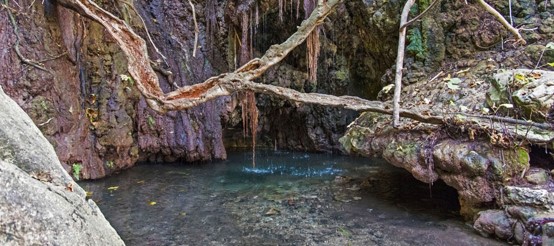
The natural grotto of the Baths of Aphrodite, and its botanical garden, can be found past the fishing harbour of Latsi, and towards the tip of the Akamas Peninsula.
Shaded by an old fig tree, amidst lush greenery, legend tells that the Ancient Greek Goddess Aphrodite used to bathe in the waters. According to Greek mythology, Aphrodite met her lover Adonis at this beautiful spot when he stopped for a drink whilst hunting, and fell in love with her the moment when he drank the water.
The site is linked to the Aphrodite Cultural Route.
Chrysorrogiatissa Monastery
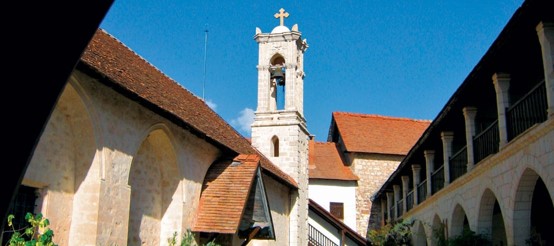
Set in beautiful natural surroundings, the Monastery of Chrysorrogiatissa is dedicated to ‘Our Lady of the Golden Pomegranate’ and was established in 1152 by monk Ignatios.
Legend tells that the monk found a miraculous icon of the Virgin Mary off the shore of Pafos (Paphos). The icon had been thrown into the sea in Asia Minor during the iconoclastic period and drifted to Pafos on the waves. The present structure – a single-aisle church built on the foundations of an older one – dates to 1770. Fine frescoes are found above the three entrances, whilst a gold and silver-plated icon of Christ and the Virgin Mary in the monastery is believed to have been painted by Apostle Luke the Evangelist. The Icons and Utensil Treasury of the monastery is also home to a collection of important icons, religious objects and other artefacts. The occasion of the Dormition of the Mother of God is celebrated at the monastery every August 15 with a grand religious ceremony, whilst the monastery’s old winery produces some of the best vintage wines on the island.
Loutra – Ottoman Hamam
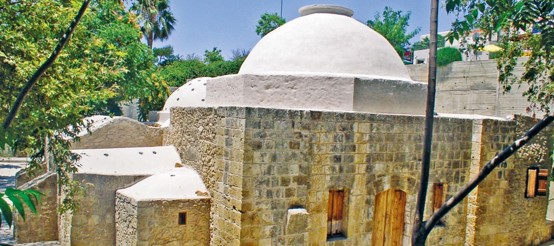
Located near the old marketplace in Pafos, the Ottoman Hamam (baths) is a stone-vaulted building with three areas: a reception area, an intermediate area and the main baths. It is believed to be of Medieval heritage despite its typical Ottoman design, and was in use until the 1950’s. Its restoration was completed in 2015.
Lempa Prehistoric Settlement
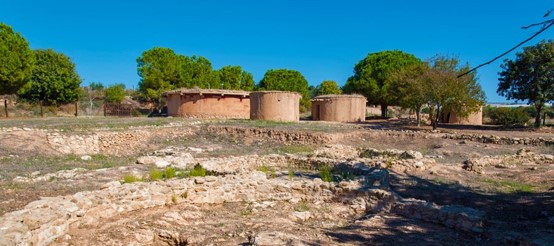
Excavations in the village of Lempa, 4km north of Pafos (Paphos), have brought to light an important settlement of the Chalcolithic Age (3900-2500 BC). Replicas of five houses from this era have been reconstructed using the same materials and building methods as used in Chalcolithic times. The site links with the Aphrodite Cultural Route.
Maa – Palaeokastro Archaeological Site and Museum
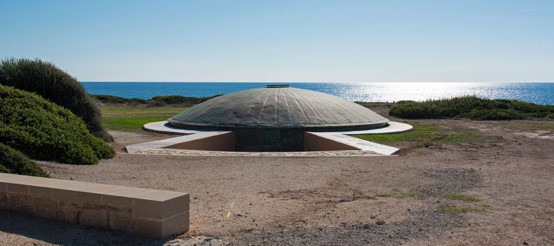
Located close to Coral Bay resort, the settlement of Maa-Paleokastro is where the first ancient (Mycenaean) Greeks settled in 1200 BC after emigrating to the island following the fall of the Mycenaean Kingdoms in mainland Greece. As such, it is a very important site for Cyprus – as this is where the Hellenisation of the island started – and offers great insight on the end of the Late Bronze Age on the island. Its name of ‘Paleokastro’ (‘old castle’ in Greek) comes from its imposing defensive walls that were always exposed. The fortifications of the settlement consist of two separate Cyclopean-style walls; the first wall protected the settlement from the land, and the second offered protection from the sea. The little museum with its unusual architecture is the work of the Italian architect-conservator and professor Andrea Bruno. The Museum depicts the colonisation of Cyprus by the Mycenaean Greeks.
Pafos (Paphos) Castle
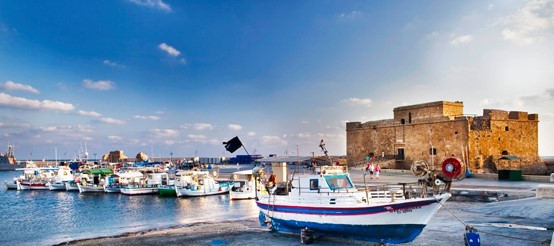
Standing grandly at the west end of the town’s harbour, Pafos (Paphos) Castle (Medieval Fort) was originally a Byzantine fort built to protect the harbour, and was rebuilt by the Lusignans in the 13th century, but then dismantled by the Venetians. The Ottomans rebuilt it in the 16th century when they conquered the island. What survives today is the 1592 Ottoman restoration of the western Frankish tower with its Venetian additions. An inscription above the only entrance of the castle bears witness to this restoration. The main part of the castle is a big square tower that has an enclosed courtyard in the middle. The ground floor consists of a central hall with small rooms on each of its two long sides, which were used as prison cells during Ottoman Rule. There are 12 battlements on the roof, which received a corresponding number of cannons. The Ottomans removed the cannons in 1878, when they handed over the administration of the island to the British, who used the castle as a salt store until 1935, when it was declared an Ancient Monument under the Antiquities Law.
Pafos (Paphos) Mosaics
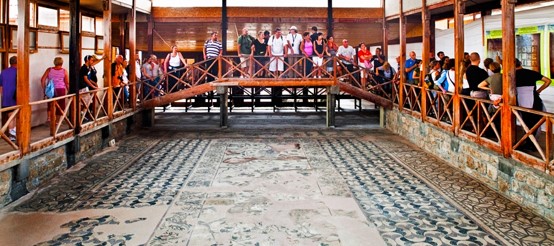
The Pafos (Paphos) Mosaics are considered among the finest in the eastern Mediterranean and form part of the Archaeological Park of Kato Pafos, which has been included in the UNESCO World Heritage Sites list since 1980. They were discovered in 1962, after a farmer ploughing his field accidently unearthed one of them. The Houses of Dionysos, Theseus, Aion and Orpheus are the villas of four Roman noblemen that date from the 2nd to the 5th centuries AD.Their intricate floor mosaics depict various scenes from Greek Mythology. The 556 square metre floor mosaics at the House of Dionysos are decorated with mythological, vintage and hunting scenes. There is also a Hellenistic pebble mosaic representing the mythical sea-monster Scylla at the entrance.
The House of Theseus is named after its oldest mosaic of the Ancient Greek hero brandishing a club against the Minotaur. Newer mosaics depict Poseidon and Amphitrite and Achilles´ first bath.
The House of Orpheus has floor mosaics depicting Orpheus among the beasts, two panels representing Hercules and the Lion of Nemea, and an Amazon with her horse.
The House of Aion has the most spectacular mosaic of five figural panels depicting: the newborn Dionysos; Leda and the Swan; the beauty contest between Cassiopeia and the Nereids; Apollon and Marsyas, and the Triumph of Dionysos. The Park also includes other sites and monuments from prehistoric times to the Middle Ages, such as the Asklepieion, the Odeon, the Agora, the Saranta Kolones (Forty Columns) Castle, and the Limeniotissa ruins of an Early Christian Basilica. The Pafos Mosaics link with the Aphrodite Cultural Route.
Palaipafos – Kouklia Archaeological Site
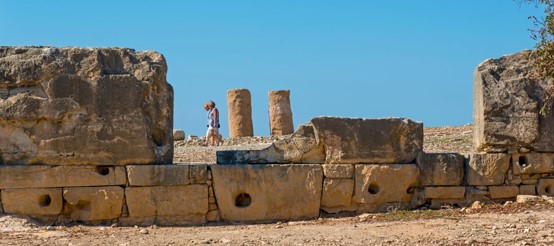
The archaeological site of Palaipafos (‘old Pafos’ in Greek) is located in Kouklia Village and was one of the most important city-kingdoms of Cyprus, as well as the first Cypriot site to be included in the World Heritage List of UNESCO in 1980. There are two versions of how Palaipafos was founded; one story tells that Agapenor, the King of Tegea (Peloponesus), founded the city-kingdom on his way back from the Trojan War. A second legend tells that Kinyras, the local legendary king (12th century) was the founder and first High Priest of The Sanctuary of Aphrodite, which is one of the most significant monuments at the site and the most famous of the Goddess’ sanctuaries. Its ancient remains date back to the 12th century BC, whilst it remained a place of worship until the 3rd – 4th centuries AD. The other significant monuments of Palaipafos are: The House of Leda; the northeast gate of the defensive wall; the city wall and the Palace of Hadji Abdulla; the Church of Panagia Katholiki; the Lusignan Manor House; the cemeteries and the Lusignan sugar-cane refinery in the coastal plain. The museum, housed in a Lusignan Manor, exhibits many interesting finds from the area and portrays how the Cult of the Goddess of Fertility developed into the Cult of Aphrodite, whilst the sugar-cane refinery is also open to visitors.
The site is linked to the Aphrodite Cultural Route.
Panagia Chryseleousa Church

Located in Empa village, 3km north of Pafos (Paphos), the Church of Panagia Chryseleousa is actually a combination of two churches and is a stone-built structure with three aisles and two domes. The eastern section was first built as a cruciform church with a dome in the 12th century, possibly on the ruins of an earlier Christian basilica. An extension was made to the west with a domed building of the cross-in-square type later on in the 13th century. The church retains its rare wall paintings of the 12th, 13th, 15th and 16th centuries, with one of the most interesting depicting the miracle of fishing. Other ecclesiastical treasures include 15th and 16th century portable icons. Among them is a noteworthy icon of Jesus Christ holding a Gospel with his left hand, and a fine icon painted on two panels with six of the Apostles on each panel.
Panagia tou Sinti Monastery
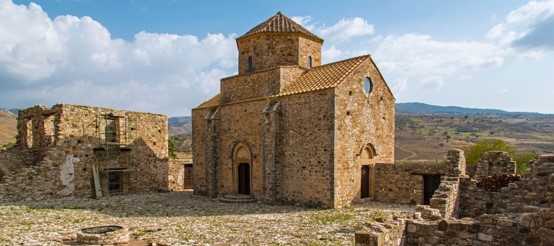
The abandoned monastery of Panagia tou Sinti is situated on the banks of the Xeros River in Pentalia, and is dedicated to the Virgin Mary (Panagia) of Sinti.
The church has an octagonal dome with four windows and belongs to the first half of the 16th century. Its central nave is in good condition, and it is considered to be one of the most important buildings of the Venetian period. The Monastery remained in operation until 1927 and thereafter was abandoned. In 1994, the Monastery of Kykkos undertook the maintenance of the Monastery, completing it in 1997 when it earned the Europa Nostra Award for the use of good restoration techniques and preservation of its original character.
Birthplace of Aphrodite – Petra tou Romiou
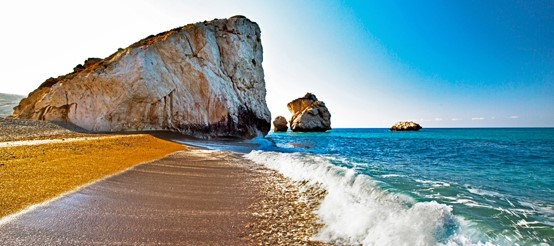
Aphrodite’s mythical birthplace ‘Petra tou Romiou’ is an interesting geological formation of huge rocks along one of the most beautiful coastlines on the island, located on the southwest coast of the Pafos (Paphos) district. According to the legend, the Ancient Greek Goddess of Love and Beauty – Aphrodite – was born of the sea foam here. Legend tells that she rose from the waves and was escorted on a shell to this particular beach. The giant rock formations, which are seen at the same location are linked with another – more recent – legend which tells that the Byzantine hero Digenis Akritas heaved them there to keep the Saracens Arabs (7th-10th centuries) at bay. The name of Petra tou Romiou (‘rock of the Greek’ in Greek) comes from the hero.
It is said that in certain weather conditions, the waves rise, break and form a column of water that dissolves into a pillar of foam. With imagination, this momentarily looks like an ephemeral, evanescent human shape. Other popular myths tell that swimming around the rock three times will bring various blessings, including eternal youth and beauty, good luck, fertility and true love.
The site is linked to the Aphrodite Cultural Route.
Sanctuary of Aphrodite at Palaipafos

The archaeological site of Palaipafos (‘old Pafos’ in Greek) is located in Kouklia Village and was one of the most important city-kingdoms of Cyprus, as well as the first Cypriot site to be included in the World Heritage List of UNESCO in 1980. The Sanctuary of Aphrodite is the most famous of the Ancient Greek Goddess’ sanctuaries, and its ancient remains date back to the 12th century BC, whilst it remained a place of worship until the 3rd – 4th centuries AD. There are two versions of how Palaipafos was founded; one story tells that Agapenor, the King of Tegea (Peloponesus), founded the city-kingdom on his way back from the Trojan War. A second legend tells that Kinyras, the local legendary king (12th century) was the founder and first High Priest of The Sanctuary of Aphrodite. The museum, housed in a Lusignan Manor, exhibits many interesting finds from the area and portrays how the Cult of the Goddess of Fertility developed into the Cult of Aphrodite.
The site is linked to the Aphrodite Cultural Route.
Saranta Kolones (Forty Columns) Castle

The Byzantine castle known as Saranta Kolones (Forty Columns) is located just north of Pafos (Paphos) Harbour, and takes its name from the large number of granite columns that were found on the site and probably once formed part of the ancient agora. The castle is believed to have been built at the end of the 7th century AD to protect the port and the city of Nea Pafos from Arab raids, and was later remodelled by the Lusignans. A three-metre thick wall with eight towers and a moat surrounded the castle. Access was across a wooden bridge spanning the moat. The square courtyard measured 35 metres long by 35 metres wide, with a tower at each corner. The main entrance was through a fifth, horseshoe-shaped tower on the east side. Destroyed by an earthquake in 1223, the castle was subsequently abandoned.
Tombs of the Kings
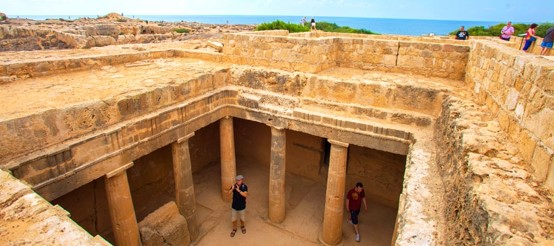
The famous ‘Tombs of the Kings’ form part of the Archaeological Park of Kato Pafos (Paphos) – one of the most important archaeological sites of Cyprus that has been included in the UNESCO World Heritage Sites list since 1980. The monumental underground tombs are carved out of solid rock and date back to the Hellenistic and Roman periods.
Rather than kings, it is actually high ranking officials and aristocracy that were buried here, but the size and splendour of the tombs – some decorated with Doric pillars – gave the locality its grand name. Some of the tombs imitate the houses of the living, with the burial chambers opening onto a peristyle atrium. They are similar to tombs found in Alexandria, demonstrating the close relations between the two cities during the Hellenistic period. The site links with the Aphrodite Cultural Route.
Early Christian Basilica-St. Paul’s Pillar-Chrysopolitissa / Agia Kyriaki Church

Located in Kato Pafos (Paphos), the Panagia Chrysopolitissa Church was built in the 13th century over the ruins of the largest Early Byzantine basilica on the island. Within the compound is St. Paul’s Pillar, where according to tradition, Saint Paul was flogged before the Roman governor Sergius Paulus was converted to Christianity.
The church was originally seven-aisled, but was later reduced to five aisles. The floor of the basilica was covered with colourful mosaics, some of which are still preserved.
Agios Andronikos Church

Located in Polis Chrysochous sub-district, this 16th century vaulted church was turned into a mosque during the Ottoman period. A northern annex was added to it and the 16th century frescoes were covered up, but these have now been uncovered and preserved.
Agios Kirykos and Agia Ioulitti Church
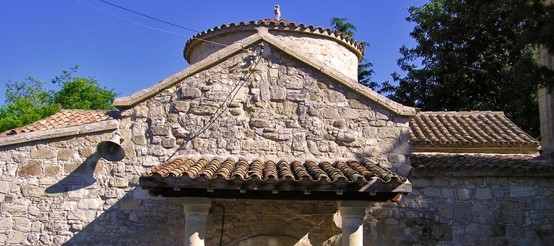
Located in Letymvou village, 16km northeast of Pafos (Paphos), the church of Agios Kirykos and Agia Ioulitti is a cross-in-square domed church dating to the 12th century, with many later additions – especially from the 15th century. It has a few surviving fragments of frescoes dating to the 12th and 15th centuries.
Agia Moni Monastery
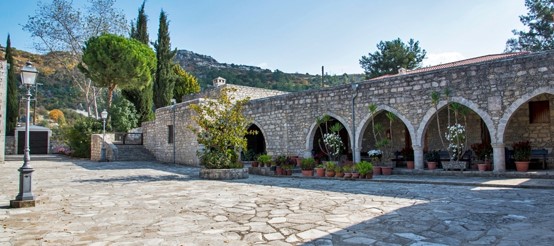
Located 38km northeast of Pafos (Paphos), Agia Moni Monastery is linked to the very origins of monasticism in Cyprus.
According to tradition, the monastery was founded around 300 AD by Agios Nikolaos and Agios Eftychios as a place of prayer and contemplation. A sacred relic – which had been given to Agios Nikolaos – and a piece of the cloak of the Virgin Mary were kept at the monastery until 1754.
Agios Ioannis Lampadistis Church

Originally a monastery, this UNESCO World Heritage Site is a complex of three churches – Ioannis Lampadistis, Agios Irakleidios and a Latin chapel – all under a single, enormous timber roof.
Located in the Troodos valley of Marathasa (just off the village of Kalopanagiotis), the precise date of the monastery’s foundation is not known, and the building complex that survives today has undergone extensive reconstruction and restoration at different periods. The church of Agios Ioannis Lampadistis was built in 1731. The saint’s tomb, which dates to the 12th century, can be found under the narrow north-eastern arch, and the saint’s skull lies in a niche. The icon of Lampadistis dates to 1543. A very interesting Byzantine museum can be found near the church.
The church of Agios Irakleidios was built in the 11th century, while its frescoes date to the 13th and 16th century. The ancient wooden templon is particularly noteworthy and is covered with gargoyles, including a heraldic Lusignan lion and Byzantine eagle. The Latin Chapel contains the most complete series of Italo-Byzantine paintings in Cyprus.
Agios Nikolaos tis Stegis Church
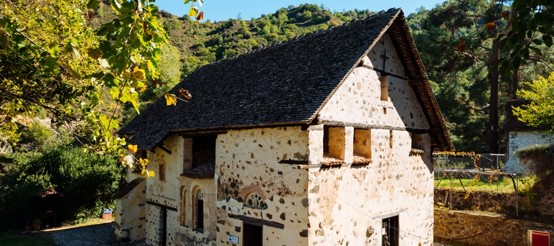
The church of Agios Nikolaos tis Stegis (St. Nicholas of the Roof) is located in the Solea Valley (5km from Kakopetria village) and is a listed UNESCO World Heritage Site.
The domed cross-in-square church once belonged to a monastery complex and derives its name from its pitched timber roof that was built to protect it from the weather. It is the only surviving monastery church of its kind on the island and is covered entirely in wall paintings from the 11th to the 17th centuries, with the most important surviving set on the island from this period. As such, it is considered one of the most interesting Byzantine churches in Cyprus. The church itself is dated to the 11th century, whilst the monastery dated to the end of the 13th or the beginning of the 14th century and flourished from the Middle Byzantine period up to the period of Frankish rule. It declined during the 18th century and ceased to function as a monastery by the end of the 19th century.
Archangelos Michael Church
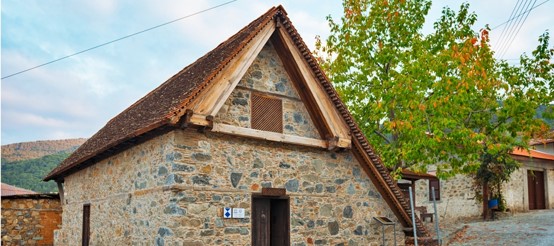
Located in the picturesque village of Pedoulas, Archangelos Michael Church is a small church that was built and decorated in 1474 by a local painter named Minas, who came from the area of Marathasa. It is on the list of UNESCO World Heritage Sites. The church is completely decorated on two levels in the local post-Byzantine style that developed prior to Venetian rule. There are 11 compositions from the Festival Cycle above, and depictions of the saints below. The Crucifixion and the Ascension are depicted in the pediments. The structure of the church has a usual sloping mountain roof and is single-aisled. The narthex, which extends to its south and west side, was used as a loft for women due to the small size of the church, whilst only men entered the main church. A wooden templon of the same period has remained intact and serves as an excellent example of its kind.
Metamorfosis tou Sotiros Church
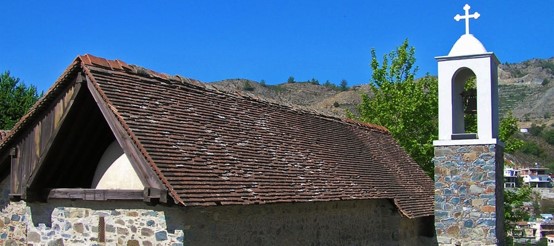
Overlooking the beautiful, old mountainous village of Palaichori, the Metamorfosis tou Sotiros Church (Transfiguration of the Saviour) is an early 16th century chapel that is a UNESCO World Heritage site. The structure is single-aisled with a timber-roof that is characteristic of Troodos region churches. The narthex, which was added by the beginning of the 17th century, extends to the west and south sides of the church and is covered by the same timber roof. The church’s interior is completely painted with one of the most complete series of murals of the post-Byzantine period in Cyprus. The unknown artist was influenced by the art of the Palaiologan period, but also draws influence from western art.
Panagia Podithou Church
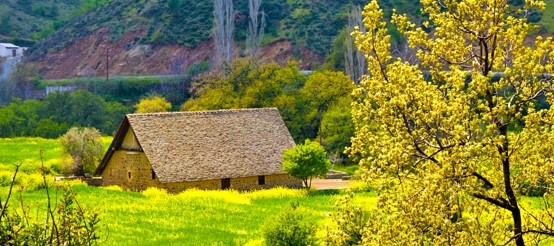
Located in the village of Galata, the church of Panagia Podithou is a listed UNESCO World Heritage Site and one of four painted churches in the village.
Once belonging to a monastery, the church was built in 1502 through the donation of Demetre de Coron and his wife Helen. Demetre, a captain of the barony of Pentageia, is known to have been involved in the political disorder of 1461. The monastery functioned until the beginning of the 19th century, but fell into decline and was finally abandoned after 1821 when the Archbishop and other notables were executed following the Greek revolution. The building is single-aisled with a steep-pitched timber roof. A later portico surrounds the three sides of the church, with the roof sheltering both the church and portico. The mural paintings are of the Italo-Byzantine style that appeared on the island towards the end of the 15th century.
Kykkos Monastery
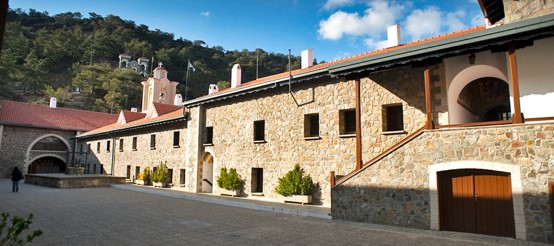
Located in the mountainous region of Marathasa Valley, the Monastery of Kykkos is the wealthiest and most lavish on the island, and stands on a mountain peak, at an altitude of 1.318 metres.
Dedicated to Panagia (the Virgin Mary), the monastery possesses one of three icons attributed to Agios Loukas (Apostle Luke) the Evangelist. The icon – covered in silver gilt – is in a shrine made of tortoiseshell and mother-of-pearl that stands in front of the iconostasis. According to tradition, Cypriot hermit Isaiah miraculously healed the daughter of Emperor Alexios I Komnenos (1081-1118 AD). As a reward, he asked for the icon, and though grieved at the prospect of losing the treasure, the emperor sent it to Cyprus, along with the funds to pay for the construction of a monastery where the sacred relic would be kept. The monastery burned down several times and nothing remains of the original structure. Today, the monastery produces Zivania spirit and other alcoholic drinks, and holds religious fairs on September 8th (Birth of the Virgin) and August 15th (Dormition of the Virgin). There is also a museum on the grounds, whilst it is noteworthy for being the monastery that the first President of Cyprus, Archbishop Makarios III served at as a novice.
Machairas Monastery
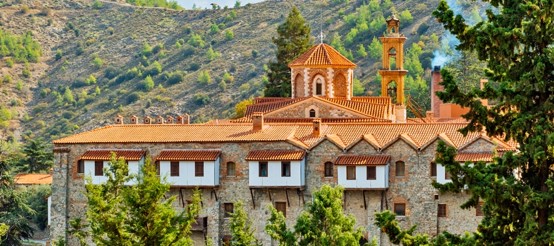
Located on the slopes of Kionia, in the valley of Machairas mountains, Machairas Monastery is one of the most famous on the island and houses the miraculous icon of Panagia (the Virgin Mary) of Machairas, which is attributed to Agios Loukas (Apostle Luke) the Evangelist. According to legend, an unknown hermit sneaked the icon into Cyprus during the iconoclasm years (between the 8th and 9th century AD) and kept it in his cave until his death around 1145. Blessed with the divine grace, the hermits Ignatios and Neophytos, discovered the cave – which was obscured by bushes – and were able to reach it by cutting down the undergrowth with a knife given to them by divine hand. As a result, the revealed icon was given the name ‘Machairiotissa’ from the Greek word for ‘knife’ – ‘machairi’. The monastery was built on the same spot, also taking the name. Today, the renovated vestry basement consists of the monks’ original cells, stables and storage areas, and houses a collection of old books and manuscripts, icons and other religious artefacts. The brotherhood at the monastery is extremely devout, keeping vows as strict as those of Mount Athos in Greece.
Panagia Asinou Church
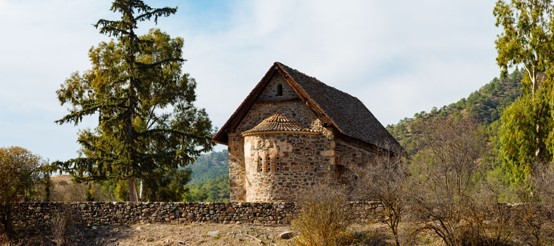
Located on the east bank of a stream, 3km from the mountainous village of Nikitari, Panagia Asinou Church is a small church dedicated to the Virgin of ‘Phorbia’. It is a UNESCO World Heritage Site and contains some of the finest Byzantine wall paintings on the island, dating from the 12th to the 17th century. The church used to be a monastery church that was built in 1099 with the donation of Magistros Nikephoros Ischyrios, who subsequently became a monk with the name Nikolaos. It functioned until the end of the 18th century, when it was abandoned. The church consists of two parts – the vaulted single-aisled nave and the narthex – which is a later addition belonging to the second half of the 12th century. The 12th century steep-pitched timber roof, covered with flat tiles, sheltered the church. Today, there are no traces of the rest of the monastic buildings. The murals inside the church date from the 12th century to the 17th century and reflect the art of Constantinople, which is thought to be the artist’s birthplace.
Panagia Chrysokourdaliotissa Church
Located in the Solea Valley, in the village of Kourdali, the church of Panagia Chrysokourdaliotissa was built in the 16th century as a monastery church dedicated to Panagia (the Virgin Mary), and according to the foundation stone, was established by deacon Leone Kourdalis. The preserved church is three-aisled, with a steep-pitched roof and flat roof tiles. The aisles of the church are divided from the nave by wooden arcades. The church contains wall paintings and icons of the 16th century in the Italo-Byzantine style, and the iconostasis is a fine example of wood sculpture of the 16th -17th centuries. In 2006, the Holy Synod decided to re-establish the Monastery.
Panagia tou Araka Church

Located in the mountainous area of Pitsilia, between the villages of Lagoudera and Saranti, the 12th century church of Panagia tou Araka is a listed UNESCO World Heritage site and is considered to be of the most important Byzantine period churches on the island. The church used to be a monastery church, built during the second half of the 12th century, when monastic life was flourishing in Cyprus. It survived until the first decades of the 19th century and its remains include a two-storey monastery building to the north, along with the church.
The church is a single-aisled domed structure with a cross-shaped, steep-pitched roof that extends to form a latticed-woodwork portico. During the 18th century, the west wall was demolished and the church was extended. The frescos inside the church are comparable to those prevailing throughout Greece, the Balkans and Russia, and were painted by the artist Theodoros Apsevdis in the late Comnenian style (1192). Those in the apse of the bema are of a different style to those in the rest of the church, and it is believed that they were painted by another artist before 1192.
Panagia tou Moutoulla Church
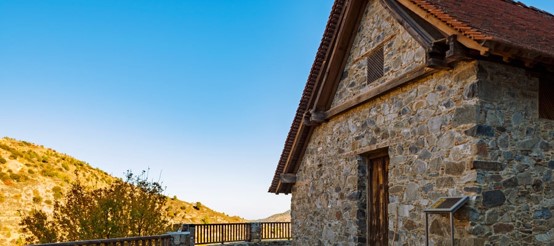
Located in the mountainous region of Moutoulla, the tiny 13th century chapel of Panagia tou Moutoulla is one of the earliest examples of its type and is a listed UNESCO World Heritage Site.
The church has a steep-pitched timber roof and frescoes dating to 1280. The narthex was added at a later stage, after the beginning of the 16th century, and extends to the west and north sides of the church. The timber roof also covers the narthex. The wall paintings are the only series of the thirteenth century (1280) that survive in Cyprus and can be dated with precision.
The church was built and decorated through the donations of Ioannis of Moutoullas and his wife Irene, who are both depicted holding a model of the church. It is believed that it may have been a private chapel. The village itself has an ongoing tradition for carved wooden basins.
Stavros tou Agiasmati Church
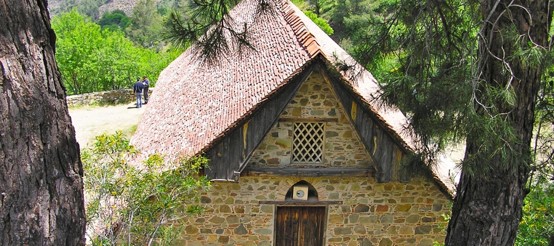
Located about 3km outside the mountainous village of Platanistasa, the 15th century church of Stavros tou Agiasmati is a UNESCO World Heritage site and retains the most complete cycles of mural paintings of the second half of the 15th century on the island. Its name derives from the word ‘Agiasma’ (-atos) which in Greek means ‘sanctified water, spring or well near a church’. The church used to be a monastery church, but only traces of the cells of the monastic buildings remain to the south of the church. The surviving structure is a single-aisled building with a steep-pitched timber roof covered with flat tiles that extends beyond the main structure to form a portico on all four sides – a feature that is unique in Cyprus. According to an inscription, the building was built with the donation of a priest named Petros Peratis and his wife Pepani, who are both depicted on a fresco offering a model of the church to Jesus with the mediation of the Virgin. Also noteworthy is the extensive and multi-person Last Judgment scene, which unfolds up to the far end of the gable where Jesus Christ is depicted. Whilst the year of the church’s erection is not known, it is generally accepted that its decoration was completed in 1494.
Timios Stavros Church in Pelendri village
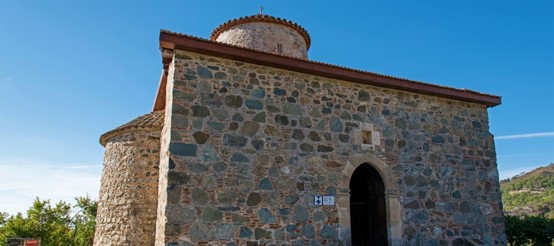
The 14th century church of Timios Stavrou (Holy Cross) in Pelendri village is decorated with exquisite wall paintings of the Palaiologan period and is a UNESCO World Heritage site.
The church was originally a single-aisled domed structure, built around the middle of the 12th century, and may have been the church of a cemetery. It was destroyed under unknown circumstances, and the present form of the church is the result of several additions and alterations, carried out throughout various periods, with only the original apse surviving.
According to an inscription in the apse, the original wall paintings date to 1171 / 1172 with fragments of the decoration preserved on the apse under the layer of the 14th century frescoes. The main part of the church was decorated during the second half of the 14th century by at least two artists. The north aisle served as a private chapel for the family of the Latin feudal lord of the area, Ioannes Lusignan (1353 – 1374 / 1375), and the village itself was once the property of Jean de Lusignan, son of the Lusignan King of Cyprus, Hugh IV.
Trooditissa Monastery

Located on the southern slopes of the Troodos mountain range, the 13th century Trooditissa Monastery is situated among pine trees, commanding a picturesque spot. The present church was built in 1731 and contains a priceless silver-leaf covered icon of the Virgin Mary brought from Asia Minor, believed to give childless couples hope if they pray to her. The exact date of the foundation of the monastery is not known, but it is believed to have been established immediately after the iconoclastic era by a hermit who resided there during the years of the iconoclasm. The church, as well as the monastic buildings, belong to a later period and can be dated to the end of the 18th or the 19th and 20th centuries. The monastery is a retreat for prayers, and as such it is closed for visits, although the church is open to visitors.
Agios Sozomenos Church

Located in the centre of the mountainous village of Galata, the church of Agios (Saint) Sozomenos dates to the early 16th century and retains a complete series of frescoes in the post-Byzantine style. It is one of four painted churches in the village. According to an inscription above the west entrance, the church was built and decorated in 1513, and 14 villagers undertook the financial responsibility of painting the church. The structure is aisle-less and timber-roofed, with the roof extending to form a portico in the shape of the Greek letter ‘pi’ (like a square ‘u’).
The church’s interior is covered with frescoes that are in generally good condition and are divided into two tiers. On the upper tier there are scenes from the Christological cycle, while on the lower tier the standing figures of saints are depicted under painted arches. In the apse of the bema, the Virgin Mary is shown between the Archangels Michael and Gabriel. The wall paintings on the external side of the north wall include scenes from the Second Coming, the Root of Jesse and the eight Ecumenical Synods.
The Church of the Archangelos Michael, or Panagia Theotokos
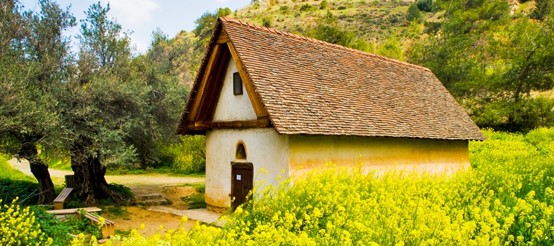
Located in the mountainous village of Galata, the Church of the Archangelos Michael, or Panagia Theotokos, is a timber-roofed chapel, painted in the post- Byzantine style of the early 16th century and one of four painted churches in the village.
Experience Culture
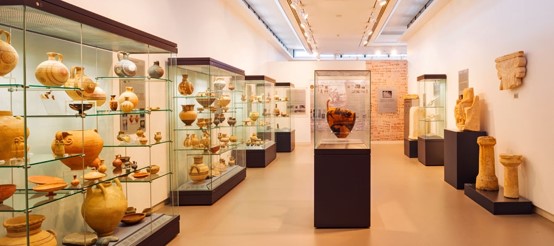
Cyprus is a small island with a long history and a rich culture that spans 10.000 years, making it one of the oldest civilisations in the Mediterranean – as evidenced by the many fascinating cultural sights, museums, monuments and galleries. Situated at the crossroads of three continents – Europe, Asia and Africa – the island’s unique geographic position has played an important part in its turbulent past since antiquity. Its Prehistoric Age inhabitants were joined 3.500 years ago by the Mycenaean Greeks, who introduced and established their civilisation, thus permanently instilling the island’s Greek roots. Many other cultures followed thereafter, including Phoenicians, Assyrians, Egyptians, Romans, Franks, Venetians, Ottomans and British, who all left behind visible remnants of their passage, and have thus created a mosaic of different cultures and periods. As such, the island is an open-air museum of prehistoric settlements, classical Greek temples, Roman theatres and villas, Early Christian basilicas, Byzantine churches and monasteries, Crusader castles, Gothic cathedrals, Venetian fortifications, Moslem mosques, and British colonial-style buildings. The old ways of life, customs and traditions are still beautifully preserved in the rural villages, and interesting elements of the island are captured in the many museums and galleries. It is not surprising then that UNESCO includes a number of the island’s sights on its list of World Heritage Sites. Whilst the preservation of historical sites and riches is of the upmost priority for the island, these efforts are in stark contrast with the unfortunate reality that a large part of its cultural heritage remains under turkish occupation since July 1974, and has been subjected to severe damage. But when visiting Cyprus, you will never have to look far to find a piece of its history and culture, whether you want to discover more about the traditions of the island, or immerse yourself in its captivating past.






















